Reducing Aviation Emissions: Strategy Report
Summary
- What are aviation emissions, and why are they important?
Aviation currently contributes 2.5% of global CO2 emissions, mainly from burning jet fuel. Non-CO2 emissions, mostly from contrails, have a further warming impact, at least as large as CO2 emissions. Under current growth trends and slow decarbonization, the sector could account for over 20% of CO2 emissions by 2050.
- What do our findings indicate to be the most promising philanthropic pathways for reducing aviation emissions?
Based on our evaluation of scale, feasibility, and funding need, we think the most promising philanthropic sub-strategies to reduce aviation emissions center on research and advocacy to mitigate aviation's non-CO2 impacts.
We also support three additional sub-strategies to promote:
1. Market-based aviation regulations
2. The development of hydrogen aircraft
3. Cross-sector prioritization on the use of hydrogen and biofuels
- Is there room for more funding?
We estimate that efforts to reduce aviation emissions receive $10-15 million in philanthropic funding per year, equivalent to less than 1% of total philanthropic climate funding.
Total climate funding from the private and public sectors for aviation totals ~$330 million per year, just 0.2% of the estimated ~$180 billion per year needed for aviation to reach net zero in 2050.
Based on this funding data, we think efforts to reduce aviation emissions are severely underfunded.
- Are there major co-benefits or potential risks?
Reducing aviation emissions has the co-benefits of reducing air pollution and its associated health impacts, reducing the adverse effects of noise pollution around airports, and creating potential technology spillovers to other transport and heavy industry manufacturing sectors.
At the same time, overreliance on sustainable aviation fuels could exacerbate food and energy security, and increasing aviation regulations could raise ticket prices, reducing access to the benefits of air travel.
- What are the key uncertainties and open questions?
Our key uncertainties include the feasibility of scaling technologies to decarbonize aviation, the tradeoff between scale and the feasibility of enacting regulations, and the risk of international carbon leakage due to national regulations.
- What is the bottom line and what are the next steps?
Given the growing demand for air travel, the need for low-carbon alternatives to fossil jet fuel, and the low level of funding this sector has historically received, we think it is important to direct more philanthropic funding toward reducing aviation emissions.
We recommend that philanthropists consider funding organizations that are working to address the challenges outlined in this report and consider grants aligned with the strategies we have laid out.
The findings in this report will inform the grantmaking strategy for the Giving Green Fund and our list of Top Climate Nonprofits. Therefore, donors interested in progressing this work can choose to donate directly to the Giving Green Fund.
This report was last updated in November 2025.
This is a non-partisan analysis (study or research) and is provided for educational purposes.
Questions and comments are welcome.
Cover image: pexels.com
Background
Aviation currently amounts to 2.5% of global CO2 emissions, mainly from burning jet fuel.1 However, aviation also generates non-CO2 emissions, which are at least as significant as its CO2 emissions.2
Including non-CO2 effects, aviation emissions have accounted for 3.5-4% of global temperature rise to date.3 Because the sector is on a growth trajectory, emissions are expected to triple by 2050.4 Current predictions of decarbonization of other sectors find that aviation could account for over 20% of CO2 emissions in 2050.5 Aviation emissions are extremely inequitably distributed, with 1% of the population emitting over half of global aviation emissions.6
Aviation is viewed as a hard-to-abate sector because, in many cases, there are no feasible alternatives to kerosene planes. Challenges to decarbonizing the industry include rapidly increasing demand, limited technological options, the high cost of low-carbon alternatives, and challenges around international coordination.7 Thus far, private sector efforts have focused on improving efficiency, buying offsets, and using waste-based sustainable aviation fuels (SAFs). However, we think that achieving substantial mitigation in the aviation sector may require more efforts to mitigate non-CO2 emissions, investment in zero-emissions aircraft (ZEAs), and incentives to manage demand.8
1 “While aviation accounts for around 2.5% of global CO2 emissions, its overall contribution to climate change is higher.” Our World In Data, 2024
2 “The climate impact of aviation's non-CO₂ effects is at least as important as the impact of aviation's CO₂” T&E, n.d. (accessed September 3, 2025)
3 “Taking all of these effects into account, the authors estimate that aviation has accounted for approximately 3.5% of effective radiative forcing to date. Another study estimates that it has been responsible for 4% of global temperature rise since pre-industrial times.” Our World in Data, 2024
4 “For example, annual emissions nearly triple assuming BAU changes (+175%), driven by surging demand for air transport…” Bergero et al., 2023
5 “If, as in the past, the ambition of these sectors continues to fall behind efforts in other sectors and if action to combat climate change is further postponed, their CO2 emission shares in global CO2 emissions may rise substantially to 22 % for international aviation.” EU, 2015; “Those emissions could triple by 2050, potentially accounting for 25% of CO2 released into the atmosphere as emissions across other sectors fall.” CATF, 2024
6 “The percentile of the most frequent fliers – at most 1% of the world population - likely accounts for more than half of the total emissions from passenger air travel.” Gössling & Humpe, 2020
7 “Why is aviation hard to abate?” Mission Possible Partnership, 2022
8 “In summary, if aviation growth is sustained, fully mitigating the climate impacts caused by the European aviation sector this coming century through offsetting and the adoption of syn-jet fuel will simultaneously require CDR and significant amounts of energy, natural and financial resources…” Sacchi et al., 2023
Pathways to Reduce Aviation Emissions
Summary of key pathways to reduce aviation emissions
1. Flight rerouting: Contrails are the largest source of aviation’s non-CO2 emissions. Contrails generation can be avoided by rerouting flight paths to avoid ice-supersaturated regions.
2. Sustainable aviation fuels (SAFs): SAFs can be made from waste, crop biofuels, or hydrogen and CO2. It will be challenging to scale SAFs due to feedstock constraints including low availability of waste feedstocks, land-use change emissions associated with crop-based biofuels, and low availability of abundant renewable energy to generate green hydrogen and CO2.
3. Zero emissions aircraft: Zero emissions aircraft, such as electric and hydrogen planes, are currently in early stages of development. Electric planes are more suitable for short-haul flights, which limits the scale of their mitigation potential. Hydrogen aircraft are more suitable for long-haul flights and could be transformative for low-carbon aviation.
4. Demand management: Demand management options include flight levies, jet fuel taxes, short-haul flight bans. We think levies that target frequent and luxury fliers could have an outsized impact. Revenues generated from levies could also be used to fund low-carbon innovation.
We see flight rerouting as an immediately actionable and important strategy to cut non-CO2 emissions. For CO2 emissions, we prioritize long-term innovations that can be used to decarbonize long-haul flights, like hydrogen-based aircraft. We think levies are an important vehicle to manage flight demand and generate revenues for low-carbon innovation.
Flight Rerouting
Contrail generation is the cause of most non-CO2 emissions from aviation. Contrails are formed when water condenses around soot particles and other aerosols from jet engine exhaust to form ice crystals.9 These crystals develop into cloud-like formations that trap heat in the atmosphere. Contrail effects are geographically concentrated in cold, humid areas, called Ice-supersaturated regions (ISSRs), with only one in every 20-25 km flown generating a persistent contrail.10 Flights can be rerouted to avoid ISSRs and generate fewer contrails.
The impacts of contrails have only relatively recently gained prominence and scientific validation. We think further development of weather forecasting, modeling, and verification tools would improve the accuracy and effectiveness of flight rerouting, and build the evidence needed to support policy proposals and corporate action on contrail avoidance.11 Alongside this, we think airspace modernization would increase the scale of contrail avoidance available through the use of more flexible and dynamic flight paths. Other challenges slowing industry action on contrail avoidance include restrictions imposed by airspace congestion, a lack of incentives for airlines to adopt the small cost of rerouting (see Assumption 2 of our Theory of Change), and the need to retrain the aviation workforce to operationalize contrail avoidance.12
Sustainable Aviation Fuels
Alternative fuels for aviation are referred to as sustainable aviation fuels (SAFs). They are low-carbon, drop-in ready fuels derived from both biological and non-biological feedstocks.13 They can broadly be split into biofuel-based SAF (bio-SAF) and electrofuels (e-SAF):
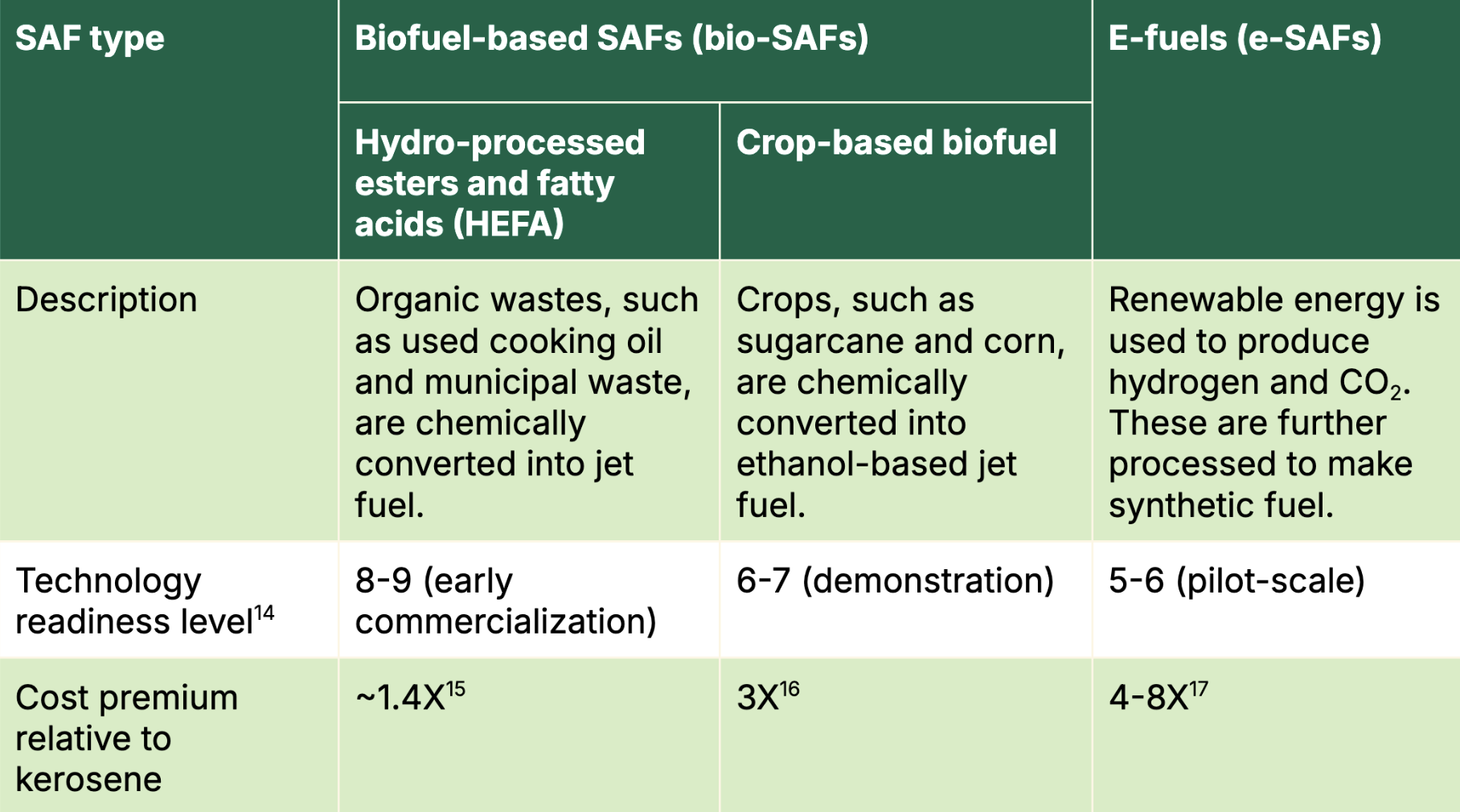
Waste-derived biofuel, also known as Hydro-processed esters and fatty acids (HEFA), is expected to dominate near-term SAF production, but is severely limited by the availability of waste feedstocks.18 Low feedstock availability, combined with high demand for HEFA, has led to cases of fraud, where palm oil has been falsely sold as used cooking oil. We think greater oversight is needed from regulatory bodies to verify environmental claims by HEFA producers.
SAF produced from crop biofuels is also expected to form a large share of SAF production in the near term. However, there are major concerns about whether bio-SAFs truly reduce emissions if accounting for their full life-cycle impacts.19 By displacing food crops, biofuel crops are at risk of driving expansion of cropland into forests and grasslands, resulting in direct and indirect land-use change emissions. A meta-analysis of life cycle emissions across various bio-SAFs found a large range in life-cycle impacts compared to the kerosene baseline (Figure 1). Most HEFA resulted in only modest emissions reductions, while crop-based biofuels led to small to moderate emissions reductions. Notably, two of the 13 fuels studied emitted more than fossil kerosene.
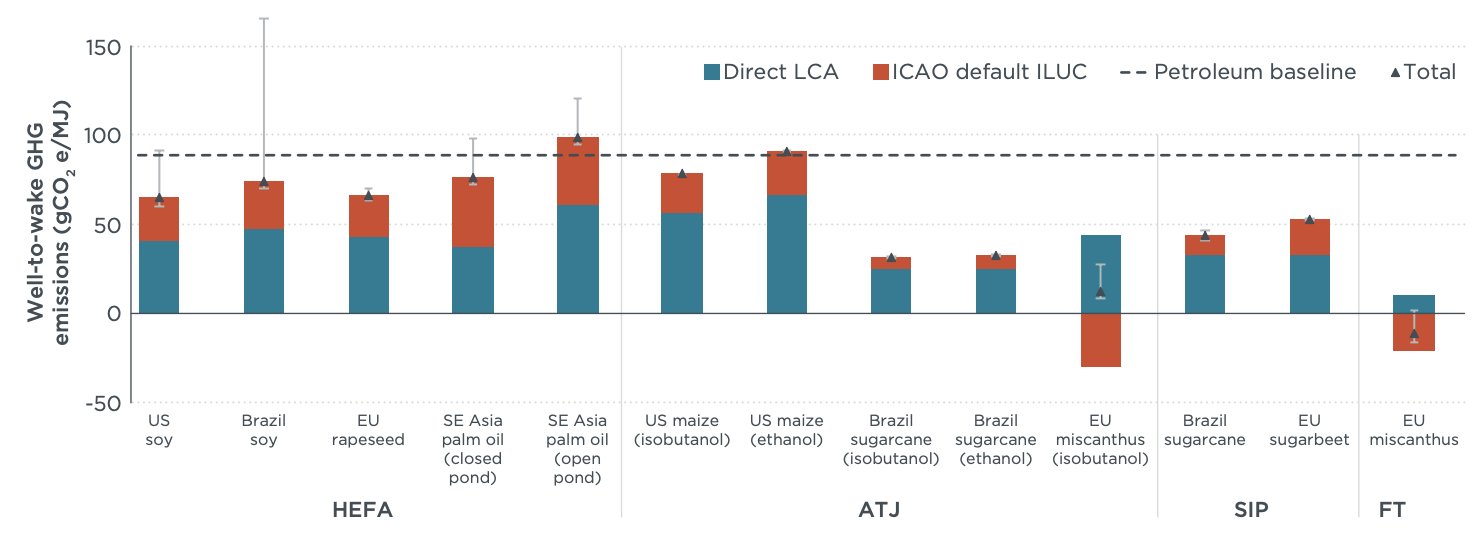
e-SAFs (also known as power-to-liquid) are produced by combining hydrogen and CO2 to produce a kerosene-like fuel. To reduce the climate impact of production, this CO2 should be sourced through captured CO2 using technologies such as direct air capture (DAC), and hydrogen should be produced through water electrolysis. e-SAFs have the potential to reduce CO2 emissions by 90% compared to jet fuel, and are usually considered the optimal type of SAF by climate advocacy groups.21 They have also been hypothesized to reduce contrail warming by 44%.22 However, e-SAFs are very energy-intensive and therefore reliant on an abundant supply of renewable energy. It has been estimated that as much as 90-100% renewable energy use in e-SAF production is needed for them to have lower life-cycle emissions than their fossil-based alternatives.23 Electricity demand for using e-SAF to fuel 2019’s aviation demand is as high as 24-39% of the world’s 2019 grid and, with costs 3.1-6.7 times as much as using kerosene.24 This is in line with results of a meta-analysis finding that e-SAF is the most expensive SAF, with an estimated minimum selling price of 2.9-5.4 times that of fossil jet fuel to break even.25
One alternative to e-SAFs to neutralize aviation emissions is to use permanent carbon dioxide removal (CDR), such as DAC. One projection of these two pathways found that, per metric ton of CO2 neutralized, DAC + kerosene would cost 33% less and use 86% less energy than producing e-SAFs (Figure 2). This finding is in line with another net-zero aviation roadmap, which considers CDR to have lower abatement costs ($50-$200 per tCO2e) than low-carbon aviation technologies ($100-$300 per tCO2e).26 The United States Department of Energy (U.S. DOE) was less conclusive in its projected mitigation costs for mature facilities, finding that SAF mitigation would cost $385-$1,425 per tCO2e abated (unsubsidized) or $83-$1,049 per tCO2e subsidized, whereas mature DAC would cost $250-$1,200 per tCO2e abated.27 We think the current evidence suggests that DAC + kerosene is likely to be more cost-effective than e-SAF-based mitigation, but are uncertain about whether this will remain true as the technologies scale.
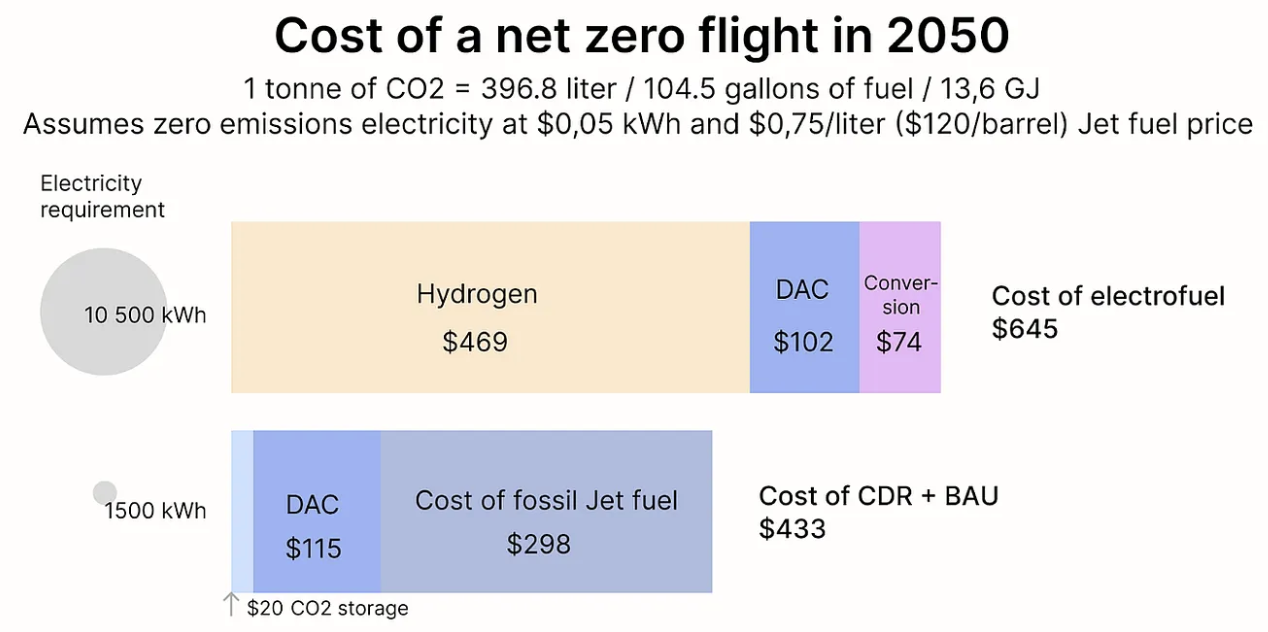
Based on the cost and resource intensity of e-SAFs, we are unsure if they will scale to meet mitigation objectives. To reduce the scale of e-SAFs needed in aviation, we think existing biofuels currently used in other transport sectors should be allocated instead to aviation. Although road transport can be decarbonized more cheaply and efficiently using electric vehicles than biofuels, biofuel is mostly still used for road transport, with less than 3% used for aviation.29 We think that biofuel supplies should be reserved for decarbonizing hard-to-abate sectors that do not have other feasible options in the near-term, like aviation.30
This could be achieved by phasing out biofuel use in road transport and dismantling policy systems, like the European Union’s (EU) Renewable Energy Directive and the United States’ Renewable Fuel Standards, that mandate biofuel use in transport, unless restricted only to aviation. In Europe, converting existing road biofuel production to bio-SAF production could meet 45% and 30% of its 2040 and 2050 SAF targets, respectively.31 Importantly, while we support redirecting biofuel production from facilities that will exist regardless of advocacy efforts opposing unsustainable biofuels, we do not support expanding total biofuel output due to the land-use conflicts stated above, and support the elimination of biofuels with high WtW emissions, such as maize biofuels (Figure 1).
Zero Emissions Aircraft
Zero-emissions aircraft (ZEAs), such as hydrogen and electric planes, are seen as the long-term pathways to decarbonizing aviation. ZEAs are currently at a technology readiness level of 6, and small, regional aircraft could become commercially viable by 2030.32
Although electric aircraft can achieve significant reductions in emissions intensity compared to kerosene aircraft (49% to 88%), their total mitigation potential is limited by their short range.33 Based on current forecasts, the maximum operating range of battery aircraft would be ~400 km by 2035 and ~600 km in 2050, roughly the distance from London to Dublin.34 Battery aircraft available in the near term have an even lower range (~280km), and would mitigate only ~0.2% of aviation revenue passenger kilometers by 2050, or 3.7 MtCO2e per year.35 While further range increases may be possible through breakthroughs in battery technology, our impression is that such breakthroughs are considerably less likely than using hydrogen-powered aircraft for long-haul flights. Under a high innovation scenario, battery aircraft range would be extended to only ~2400 km (roughly the distance from New York to Dallas).36 Therefore, our strategy does not include battery aircraft as a core technology.
We think that hydrogen aircraft, including hydrogen-electric propulsion, are likely to play a greater role in aviation decarbonization than battery electric aircraft because they could more easily be used for long-range flights, which account for nearly half of the aviation sector’s emissions.37 In the long term, they could also be cheaper than e-SAFs: Hydrogen and bio-SAF flight ticket costs are projected to be similar in 2050, roughly 33% more than kerosene flight tickets. Meanwhile, e-SAF flight tickets are expected to cost an additional 81% compared to kerosene.38
In addition, some consider methane aircraft to be a compromise between hydrogen aircraft and e-SAFs. While not ZEAs, they produce fewer tailpipe emissions than kerosene-based planes due to their lower carbon content, and their fuel production costs are also cheaper than e-SAFs.39 Methane aircraft present fewer technical design challenges than hydrogen aircraft because cryogenic methane has a higher energy density and a milder storage temperature than cryogenic hydrogen.40 Methane can also be distributed through existing natural gas infrastructure, so methane-based aviation is not limited by the buildout of new hydrogen infrastructure. However, methane aircraft could also be used as an excuse to prolong the lifetime of the natural gas industry. An additional challenge is that, similarly to methane-based shipping vessels, methane leakage throughout the supply chain could lead to substantial additional methane emissions compared to using fossil fuels.41 In addition to ZEA development, we are cautiously open to exploratory research to evaluate whether methane aircraft are a desirable pathway to reducing aviation emissions.
Demand Management
Aviation emissions can also be reduced through demand management. Since aviation emissions are mostly a result of a small group of frequent fliers, strategies that aim to change the behavior of this group can have an outsized mitigation impact.42
One way to manage demand is by incentivizing alternative modes of transport, including efforts to improve rail infrastructure in geographies where feasible or to reduce excessive travel. In 2021, France banned flights with a rail alternative under 2.5 hours. However, since these flights make up just a minority of total aviation emissions, this policy was found to reduce France’s aviation emissions by only 0.8%.43 Emissions could be further reduced by 4.5% if the limit were doubled to 5 hours.
The other main method of flight demand management is through levies that increase the cost of flying. We advocate for levy designs that target high-income and frequent fliers, reducing the cost burden for low- and middle-income households. Various levies have been proposed, including:
- Luxury flying levy: In 2025, eight countries, including France, Barbados, and Kenya, launched a ‘solidarity’ coalition calling for a tax on premium air travelers. Their research found that global levies on business and first-class tickets and on kerosene used for private jets could raise €37 billion ($43 billion) and €14 billion ($16 billion) per year, respectively.44 The coalition has partnered with the European Commission and is building towards action at COP30 in 2025.45
- Frequent flier levy: A study proposing a combined frequent flyer and luxury flying levy – which would target the 11% of people who fly more than three times a year and those able to afford premium tickets – found that it could raise €64 billion ($74 billion) in annual European revenues, without a financial cost to most people.46 According to the study, the levy would result in 21% fewer aviation emissions, mainly as a result of the top 5% of frequent fliers taking fewer flights.47 90 organizations and 47 academics have signed a public statement in favor of the levy.48
- Jet fuel tax: Because of the international nature of the sector, kerosene is mostly untaxed, in contrast to most other transport sectors. One estimate claims that if the full carbon impact of kerosene were reflected in a European tax, it would be €0.38/liter ($0.44/liter).49 Such a tax could raise €47 billion ($55 billion) in annual revenue and save 34.8 MtCO2e per year in emissions.50
In addition to managing demand, revenues could also fund innovation for low-carbon technology, resulting in additional climate benefits.
Assessment of Key Technologies
Since the aviation sector’s warming impact is expected to roughly triple from today’s levels by 2050, with a further 2-4x increase in 2100, most aviation emissions will occur in the future.51 We therefore place less weight on securing low-carbon technology in the mid-term and instead favor innovation options with large long-term mitigation potential, such as ZEAs. We think hydrogen aircraft would be the most suitable technology to replace long-haul flights because they have a lower expected resource intensity and cost than fueling aircraft with e-SAFs. We think early innovation in hydrogen aircraft is especially critical to reducing the risk of the sector becoming over-reliant on SAFs.
The development and scaling of e-SAFs and hydrogen aircraft are closely linked to the progress and policy of hydrogen, given that hydrogen is a key enabling feedstock for these technologies. Despite growing policy efforts, incentives remain insufficient to scale low-carbon hydrogen production, especially green hydrogen, to meet cross-sector climate goals. In particular, most policies address supply-side barriers, such as by providing subsidies and R&D funding, but advocates argue that more demand-side policy is needed.52 Since clean hydrogen demand far exceeds supply, we think there should be stronger guardrails on its use.53 For example, guardrails could involve preventing hydrogen use in sectors where cost-effective and readily available decarbonization options exist, such as road transport, buildings, and power generation.54 Instead, guiding its use towards hard-to-abate sectors would maximize emissions savings.55
Finally, other technologies, such as CDR, may be needed as bridge technologies to develop transformational technologies like zero-emissions aircraft. We remain cautious about the risks of over-reliance on CDR, mainly because of challenges verifying the credibility of carbon accounting mechanisms and the risk that continued use of fossil jet fuel is used to justify continued crude oil extraction (see section ‘Potential risks’ in our CDR strategy report).56 We advocate for a mixed approach, involving both mitigation and CDR.
9 “Contrails, high-altitude cirrus-like clouds, are formed when water vapor and soot, emitted at high temperatures from jet engines into very cold air in cruise flight, bond to form ice crystals.” Rose-Tejwani, A. T., Sherry, L., & Ebright, K., 2025
10 “When the air temperature is specifically less than or equal to −41.1 °C (−41.98 °F) and its relative humidity with respect to ice is at least 100%, a contrail will form and persist.” Rose-Tejwani, A. T., Sherry, L., & Ebright, K., 2025; Section: Operation Blue Skies: 2050 ticket cost AIA, 2024; “only about 1 in every 20 to 25 kilometres flown generates a persistent contrail that requires an altitude change” AIA, 2024
11 Section: “Smarter flight routing: Avoiding contrail-forming conditions” CATF, 2025; ““The main challenge in implementing an effective contrail avoidance system lies in the numerous uncertainties, from the underlying science to the variety of potential implementation methods. The ideal way to address these uncertainties is through a learn-by-doing approach in a realistic, field-based environment.” AIA, 2024
12 “Focus in these areas is required to accelerate implementation: Congestion: Many regions have congested airspace, limiting opportunities for contrail avoidance. Incentives: Although the cost of contrail avoidance could be very low (2050 Ticket Cost), operators need incentives to adopt the necessary behaviours. Measuring contrail absence: There is a practical challenge in accurately determining whether a contrail would have formed without avoidance measures. Operational change: Shifting the behaviour of thousands of individuals and introducing new systems will be difficult.” AIA, 2024
13 “Sustainable aviation fuels (SAF) are low-carbon fuels produced from biological (i.e., plant and animal materials) and non-biological (i.e., municipal solid waste, industrial waste gases) feedstocks, which have similar physical and chemical characteristics as conventional jet fuel but with a lower life-cycle carbon footprint.” IEA, 2019
14 Figure 25: Decarbonization TRLs and year of commercial availability, WEF, 2024
15 Infographic: Not all SAFs are created equal; Climate Catalyst, 2024
16 Calculation: 60/20 = 3X more expensive “production costs between … USD 60/GJ for aviation (USD 20/GJ for fossil fuel jet fuel).” IEA, 2023
17 “An optimised large-scale plant, located on a site with high-quality solar PV and wind resources with complementary profiles, and having access to low-cost biogenic CO₂ feedstock, could produce e-kerosene at a cost of USD 80/GJ (USD 3 500/t), around 4-5 times the price of conventional jet fuel today (USD 750-1 000/t).” Climate Catalyst, 2024 “e-saf’s >5-8x green premium makes it uncompetitive against conventional jet fuel today…” Breakthrough Energy, 2024
18 “Two-thirds (66%) of survey respondents expect HEFA to dominate SAF production by 2030.” Simpliflying, 2025 “However, demand is approaching the supply limits of the most-used wastes and residues.” IEA, 2022
19 “Many scientists and international regulatory bodies have concluded that growing crops to make aviation fuel does not reduce emissions on a full lifecycle basis (from crop production through to processing and consumption).” WRI, 2024
20 Figure 6: Well-to-wake GHG emissions for crop-based SAFs relative to petroleum jet fuel baseline ICCT, 2023
21 Figure 3 Life-cycle GHG emissions for different fuels and transport applications as a function of the life-cycle carbon intensities of electricity used for battery charging, hydrogen and e-fuel production. (right) Ueckerdt et al., 2021 “These e-fuels — referred to interchangeably as e-SAF or e-kerosene in this report — are the most scalable and sustainable form of SAF.” T&E, 2025
22 “A fleetwide adoption of 100% SAF increases contrail occurrence (+5%), but lower nonvolatile particle emissions (−52%) reduce the annual mean contrail net radiative forcing (−44%), adding to climate gains from reduced life cycle CO2 emissions.” Teoh et al., 2022
23 “Across transport applications, 90–100% renewable electricity shares are required for e-fuel use to reduce GHG emissions compared with their fossil alternatives.” Ueckerdt et al., 2021
24 Line: Power-to-liquid, RECCE tool AIA, 2022
25 Calculation: [2023.6, 3708.6]/690 = [2.9, 5.4] lower and upper quartile values for Power-to-liquid (PtL) from Table 3: Descriptive statistics of the SAF minimum selling price/production cost meta study.; “For comparison, the authors assumed an average fossil jet fuel price (2010–2021) of 690 USD” Braun, Grimme & Oesingmann, 2024
26 Exhibit C: How net zero by 2050 could be achieved; MPP, 2022
27 “However, compared to other premium carbon management solutions, SAF may be competitive. On a per metric ton of carbon abated basis, SAF from a hypothetical NOAK facility could cost between $385-1,425 (unsubsidized) or $83-$1,049 (subsidized—see Appendix 4 for a detailed methodology and assessment of the impact of federal and state incentives). By contrast, a similarly mature Direct Air Capture (DAC) plant might cost $250-1,200 per metric ton of carbon abated.” DOE, 2024
28 Figure: Cost of a net zero flight in 2050 Robert Hoglund, 2024
29 We have high certainty in this statement for light-duty vehicles and medium certainty in this statement for heavy-duty vehicles (see Section: Battery electric trucks become competitive for long-haul applications this decade in China and Europe in IEA, 2025) Figure: Global biofuel demand in transport in the Net Zero Scenario, 2016-2030 IEA, n.d. (accessed 1 August 2025)
30 “The study considers the most relevant powertrain types—internal combustion engine vehicles (ICEVs), including hybrid electric vehicles (HEVs); plug-in hybrid electric vehicles (PHEVs); battery electric vehicles (BEVs); and fuel cell electric vehicles (FCEVs)—and a variety of fuel types and power sources including gasoline, diesel, natural gas, biofuels, e-fuels, hydrogen, and electricity” “The impact of future changes in the biofuel blends driven by current policies range from a negligible influence to a reduction of the life-cycle GHG emissions of gasoline, diesel, or natural gas vehicles by a maximum of 9%” “Only BEVs and FCEVs are capable of a deep decarbonization of passenger cars. As shown for average new medium-size cars in Figure 1, the life-cycle emissions over the lifetime of BEVs registered today are lower than comparable gasoline cars in all four regions.” ICCT, 2022
31 “Converting 100% of today’s EU liquid biofuel production to biojet fuels could help achieve 45% and 30% of the 2040 and 2050 targets, respectively.” FCA, 2024
32 Figure 25: Decarbonization TRLs and year of commercial availability WEF, 2024
33 “Electric aircraft can provide a 49% to 88% reduction in CO2e emissions relative to fossil-fueled reference aircraft.” ICCT, 2022
34 “Based on forecast battery gravimetric energy densities, the maximum operating range of lithium-ion battery-electric aircraft by 2035 is expected to be around 400 km, rising to 600 km in 2050.” WEF, 2022
35 “With advanced battery technology (eb = 500 Wh/kg), the larger 90Bolt could cover 280 km missions.” “By 2050, electric aircraft could mitigate 3.7 Mt of CO2e annually. This would represent 0.2% of the projected emissions from passenger aviation in 2050. ” ICCT, 2022
36 “We assume that the enhanced GED will be utilised to extend the aircraft's range from 420 nautical miles in scenario one to 840 nautical miles and 1280 nautical miles in the second and third scenarios.” Sisimanidou, 2024
37 “Long-range flights account for nearly half of the aviation sector’s emissions yet involve replacing only around 5,000 aircraft and converting approximately 50 of the world’s largest hub airports.” AIA, 2024
38 Section: Moonshot Demonstrator: 2050 Ticket Cost AIA, 2024
39 “With a higher H/C ratio, LNG leads to increased H2O emissions while reducing CO2 emissions. Additionally, since LNG contains less sulfur than Jet A-1, its SO2 emissions are significantly lower. In summary, LNG demonstrates a more environmentally friendly emission profile compared to Jet A-1, making it a promising alternative for aviation fuel.” Wei et al., 2025 “Its renewable production is simpler and less resource-intensive compared to SAFs” AIA, 2024
40 Figure 6: Aviation energy source comparison of different fuels relative to Jet-A, and Table 1. LNG, LH2 and petroleum-derived fuel properties; Wei et al., 2025
41 “The authors use a representative life-cycle emission factor as well as the 100-year and 20-year global warming potentials (GWPs) for methane included in the Intergovernmental Panel on Climate Change’s Fifth Assessment Report. The 20-year GWP better reflects the need to reduce GHGs quickly, in order to meet the International Maritime Organization’s (IMO) climate goals, and the results show that when combined with a trend toward higher leakage, there is no climate benefit from using LNG, regardless of the engine technology.” ICCT, 2020
42 “The percentile of the most frequent fliers – at most 1% of the world population - likely accounts for more than half of the total emissions from passenger air travel.” Gössling & Humpe, 2020
43 “Short-haul flights make up just a small minority of total aviation emissions. Our calculations last year showed that such a ban would reduce French aviation emissions by only 0.8%. Expand that to where a rail alternative of under five hours exists and that number goes to 4.5%.” T&E, 2021
44 37 billion: “Levies on business and first-class tickets for international and domestic flights and on kerosene used for private jets could raise respectively up to 37 billion euros ($43.7 billion) and 41 billion euros ($48.5 billion) per year if implemented globally.” Climate Home News, 2025; Figure 1: Revenue generating potential of the different aviation levies CE Delft, 2025
45 “It will be supported by the European Commission, and the Global Solidarity Levies Task Force as part of the Pact for Prosperity, People and the Planet (4P). The coalition will work towards COP30 on a better contribution of the aviation sector to fair transitions and resilience, with a special focus on premium flyers.” Global Solidarities Levies Task Force, 2025
46 The proposed levy includes surcharges for medium- and long-haul flights, business class seats, and passengers flying over two times in 12-months. “A frequent flying levy across Europe would increase aviation tax revenues to €64bn, without any financial cost to the majority of people” “On average, just 11% of people fly more than three times a year.” New Economics Foundation, 2024
47 “The report also finds that a frequent flying levy would result in a 21% drop in aviation emissions, mainly as a result of just 5% of people — the most frequent flyers — taking less flights.” New Economics Foundation, 2024
48 “90 organisations and 47 academics have signed a public statement also released today in support of a frequent flyer levy for the EU.” New Economics Foundation, 2024
49 “Fuel taxation is applied to all kerosene uplifted at a rate of €0.38 (£0.35 ) per litre.” T&E, 2023
50 “If national & European governments fail to remove tax exemptions, the tax gap is set to increase to €47.1 billion in 2025.” “We find that ending tax exemptions in 2022 would have saved 34.8 Mt of CO2.” T&E, 2023
51 “As a reference, in 2000, the calculated impact of aviation CO2 emissions is 9.1 ± 2 mK (0.8% of the total anthropogenic warming associated to fossil fuel emissions). In 2050, on a climate trajectory in line with the Paris Agreement limiting the global warming below 2 °C (RCP2.6), the impact of the aviation CO2 emissions ranges from 26 ± 2 mK (1.4% of the total anthropogenic warming associated to fossil fuel emissions) for an ambitious mitigation strategy scenario (Factor 2) to 39 ± 4 mK.” “In the longer term, if no significant emission mitigation is implemented for the aviation sector, the associated warming could further increase and reach a value of 99.5 mK ± 20 mK in 2100 (ICAO based).” Terrenoire et al., 2019
52 “However, creating the green hydrogen market necessary for decarbonization requires sufficient demand-side policy that incentivizes that change. For the green hydrogen market to really scale, these policies will need to exist in the form of sectoral standards or sector-based or economy-wide carbon policies.” Rhodium Group, 2023
53 “Low-carbon H2 can only meet a minimal fraction of today’s European demand.” FCA, 2025; “BNEF expects clean H2 supply to skyrocket 30-fold to 16.4 million metric tons per year by 2030, driven by supportive policy and a maturing project pipeline. Still, this is not sufficient to meet most government targets.” Bloomberg NEF, 2024
54 “Road transport, buildings, and power generation should be excluded from hydrogen deployment strategies or public funding support. “ FCA, 2025
55 “However, these sectors have more effective and readily available decarbonization solutions (e.g., electrification). These solutions should be opted for to maximize emissions savings and ensure hydrogen is both readily available and prioritized for those essential and hard-to-abate sectors.” FCA, 2025
56 “Offsetting fossil emissions with carbon removals requires transparent auditing to ensure credibility and prevent double counting. Additionally, continued use of fossil jet fuel might be used to justify ongoing crude oil extraction.” AIA, 2024
The Current Policy Landscape
Decarbonizing aviation will require a combination of policies and regulations to manage demand, promote contrail mitigation and low-carbon technologies, and support the supply of requisite feedstocks like low-carbon hydrogen. Our impression is that there has been an uptick in policies supporting the decarbonization of aviation over the last five years, especially in the EU. However, even in the presence of existing policy, these sectors remain off track in terms of progress toward net-zero emissions.57 To inform our theory of change, we briefly describe relevant governing bodies and some existing policies and policy gaps.
The International Civil Aviation Organization (ICAO)
The International Civil Aviation Organization (ICAO) is a UN agency that regulates international aviation. ICAO has a long-term global aspirational goal for international aviation to reach net-zero emissions by 2050.58 It also established the Carbon Offsetting and Reduction Scheme for International Aviation (CORSIA) in 2016. This scheme requires all airlines to offset emissions beyond a baseline of 85% of the industry’s 2019 emissions.59 However, CORSIA’s effectiveness in reducing emissions has been critiqued for several reasons:
- Its baseline is unambitious, affecting only 22% of aviation emissions.60
- The scheme remains voluntary until 2027, with low participation (129 states in 2025).61 After it enters its mandatory phase, its participation is expected to remain low in some key markets.62
- The integrity of offsets used in CORSIA has been criticized for not sufficiently preventing double-counting and allowing low-quality offsets to enter the scheme.63
- CORSIA does not account for non-CO2 emissions, leaving two-thirds of aviation emissions unmitigated through the scheme.
In addition, ICAO has been criticized for its lack of transparency, exclusion of scientists and civil society, and prioritization of private sector interests.64 Many advocacy groups do not consider ICAO a key political lever for these reasons.
The European Union
The EU has among the most ambitious aviation policies in the world. The EU Emissions Trading Scheme (ETS) is the largest carbon pricing scheme for aviation, covering flights within the European Economic Area (EEA) and the United Kingdom (U.K.).65 Under the scheme, airlines must buy allowances for each ton of CO2 emitted beyond a cap, which decreases over time. Some of these allowances have also been reserved for airlines that use SAFs to promote their uptake.66
By 2026, the European Commission is mandated to assess CORSIA’s effectiveness at reducing aviation emissions. If deemed insufficient, the EU must increase the scope of its aviation ETS from intra-EEA to include all flights departing from the EEA.67 This expansion would increase the CO2 emissions covered by the ETS from 60 MtCO2 per year to almost 150 MtCO2 per year.68
A separate EU initiative, the Fit for 55 package, aims to reduce the EU’s emissions by 55% by 2030. It contains the ReFuelEU aviation mandate targeted toward increasing the use of SAFs. From 2025, airlines are mandated to include an increasing share of SAFs in their fuel, starting at 2% and growing to 70% by 2050.69 The mandate also includes specific targets for e-SAFs of 1.2% in 2030 and 35% by 2050.70 EU airports must also develop the necessary infrastructure to supply SAFs to airplanes, and a consumer-facing labeling system will indicate operators using SAFs.
Other Countries
The U.K.’s SAF Mandate is seen as one of the most progressive in the world, starting at a 2% mandate in 2025 and rising to 22% in 2040, with additional sub-targets for the use of e-SAFs.71 It is accompanied by the U.K. ETS for aviation, which is linked to the EU ETS, covering flights in the U.K. and the EEA, and a SAF Revenue Certainty Mechanism, which reduces the price volatility of SAF imposed on fuel producers.
In the Inflation Reduction Act (IRA), the U.S. passed a Clean Fuel Production Credit that allocates credit amounts for SAF and non-SAF fuels corresponding to their emissions factors. However, in 2025, the Trump administration softened the bill, reducing the financial credit for producing SAF from $1.75 per gallon to $1 per gallon and cutting the required integrity of bio-SAFs by excluding indirect land use change emissions from life cycle assessment (LCA) calculations.72 In addition, the fate of the Sustainable Aviation Fuel Grand Challenge, a U.S. government-wide approach intended to scale SAF production to meet 100% demand by 2050, is highly uncertain under the Trump administration.73
SAF requirements have been introduced in Indonesia, Brazil, the U.K., and Japan. The IEA's list provides more examples of country-level policies relevant to decarbonizing aviation.
Non-CO2 Effects
As of 2025, aircraft operators in the EU must report on the non-CO2 effects of aviation.74 To our knowledge, this policy is the only one in the world covering non-CO2 emissions. Given that non-CO2 emissions are at least as significant as its CO2 emissions, we consider it a priority to expand both the geographic coverage of such policies and to start considering mitigation measures in addition to just monitoring, reporting, and verification.
57 “New technologies, fuels and operational measures can help reduce the industry’s greenhouse gas emissions, but without appropriate laws and policies, it will be difficult to achieve the targets set by the industry.” Dong, J. et al., 2022; “The role of policy in enabling an industry transition to support aviation’s goal to reach net zero carbon emissions by 2050, is key. Only with a predictable policy framework, encompassing all aspects of regulation, can all industry stakeholders confidently invest the amounts required to bring revolutionary, carbon-saving technologies to market with the necessary speed…” IATA, 2023
58 “Strategic Goals: Achieve net-zero carbon emissions by 2050 and mitigate aircraft noise and emissions.” ICAO, 2024
59 “Assembly, ICAO set 85% of 2019 emissions as CORSIA’s baseline from 2024 until the end of the scheme in 2035.” IATA, 2024
60 “…a mere 22% of total international aviation emissions would be covered by the scheme and therefore offset.” T&E, 2025
61 “Three more States (Comoros, Mauritania, and Saint Lucia) will participate in CORSIA from 1 January 2025, bringing the total number of participating States to 129.” IATA, 2025
62 “From 2027, all international flights will be subject to offsetting requirements. However, flights to and from Least Developed Countries (LDCs), Small Island Developing States (SIDS), Landlocked Developing Countries (LLDCs) and states that represented less than 0.5% of global international RTK in 2018 will be exempt from offsetting requirements unless these states participate voluntarily.” IATA, 2024; “More intriguingly, despite it being meant to be a global scheme, participation remains limited as key aviation markets are missing either by not joining (e.g. China, Russia) or by not implementing CORSIA to the national laws (e.g. USA).” T&E, 2025
63 “These first credits set a terrible precedent, not only for CORSIA but for the voluntary carbon market at large, as CORSIA approval will give legitimacy to credits that are inherently incompatible with offsetting.” Carbon Market Watch, 2024; “CORSIA offsets lack credibility due to the low-quality and inconsistent offset standards, which also makes double counting possible with the country's NDCs.” T&E, 2025; “...we estimate that up to 113 million of the 240 million new credits for emission reductions to the end of 2020 shown in Figure 9 are at risk of being double-counted.” European Commission, 2020
64 “In the past few years ICAO has faced criticism and been seen rightly or wrongly as an outlier even in the UN system for its lack of transparency in decision-making, its lack of access to information by the media, undue influence of industry (“captured by producer interests”: The Economist), restricted involvement of civil society and independent scientists, and its political interference in the culture and workings of the Secretariat.” Centre for Aviation, 2021
65 “Currently, the EU Emissions Trading System (EU ETS) for aviation only prices emissions from flights between and within the European Economic Area (EEA) and from the EEA to the UK and Switzerland.” T&E, 2025
66 “Sets a cap on carbon emissions that tightens over time. Obligated industries are required to buy allowances for each ton of carbon emitted above this cap and are thus incentivized to reduce emissions due to the cost of purchasing carbon credits or allowances. A total of 20 million “free” allowances are reserved for airlines that use SAF, serving as a quasi-incentive.” WEF, 2024
67 “During the latest revision, it was extended one last time, until the start of 2027. By July 2026, the Commission will carry out an assessment of whether more action is required for flights to and from Europe, in line with criteria set in the EU ETS Directive. Subject to the outcome of this assessment, the Commission will make a legislative proposal that could extend the scope of EU emissions trading to departing flights and exempt incoming flights.” European Commission, n.d. (accessed August 2, 2025)
68 Figure 2: Aviation CO2 emissions for intra-EEA flights (current EU ETS scope) and all EEA departing flights (possible scope extension) CE Delft, 2024
69 “It sets requirements for aviation fuel suppliers to gradually increase the share of SAF blended into the conventional aviation fuel supplied at EU airports.” “2% Share of SAF in EU airports from 2025 70% Share of SAF in all EU airports from 2050” European Commission, n.d. (accessed April 24, 2025)
70 “1.2% Share of synthetic aviation fuels in all EU airports from 2030 35% Share of synthetic aviation fuels in all EU airports from 2050” European Commission, n.d. (accessed April 24, 2025)
71 “In 2025, the main obligation is set at 2% of the total fossil jet fuel supplied, which is approximately equal to 230,000 tonnes of SAF. This will increase annually to reach 10% in 2030 and 22% in 2040. The power-to liquid obligation will be introduced from 2028 at 0.2% of total jet fuel demand and will reach 3.5% of total jet fuel demand in 2040.” U.K. Department of Transport, 2024
72 “While the original 45Z structure offered SAF producers up to $1.75/gallon, the final bill reduces that to $1.00/gallon.”; “Notably, the bill excludes indirect land use change (ILUC) from lifecycle emissions calculations.” ResourceWise, 2025
73 ‘SAF Grand Challenge in Limbo as New Administration Takes Office’ Energy Intelligence, 2025
74 “…the co-legislators stressed the need to address these non-CO2 effects and mandated the Commission to establish a monitoring, reporting and verification system for these effects, to be operational from 1 January 2025.” European Commission, 2024
Industry Action
Industry initiatives like the IATA’s resolution and Destination 50 net-zero commitments, as well as various industry SAF offtake agreements, signal some industry intent to reduce emissions. However, despite external pressure from advocacy groups, our impression is that climate action is not a top priority for the aviation industry.75
We think the most likely incentive for the private sector to take action is regulatory pressure. Because regulation can be applied to all companies in a given region, airlines could spend money on decarbonization with fewer trade-offs to their industrial competitiveness. Taking SAF as an example, policy has been highlighted as a strong enabler for climate action. In an aviation industry survey, uncertainty in long-term policy support was seen as the top barrier to financing new SAF production (43% of respondents), and lack of clear mandates was also cited as a top non-financial barrier (45% of respondents) to adopting SAF.76 We therefore choose to focus advocacy on governments rather than directly on the aviation industry.
75 An offtake agreement is a contract where a buyer agrees to purchase a specific amount of a seller's future product or service. This helps the seller secure financing and reduces risk, while the buyer gets a guaranteed supply of goods. “Under the Memorandum of Understanding (MOU) agreement Twelve will also work with the companies toward a demonstration flight proving viability of commercial use of e-fuel, and to provide low carbon jet fuel for Microsoft's business travel on Alaska.” Alaska Airlines, 2022
76 Chart: Top barriers to financing new SAF production; Chart: Top barriers to adopting SAF Simpliflying, 2025
Assessment of Philanthropic Sub-Strategies
We evaluate each sub-strategy's scale, feasibility, and funding need (see table below). For more information on these metrics and our research process, see Giving Green's Research Overview.
Scale, feasibility, and funding need of various approaches nonprofits use to promote the decarbonization of aviation
- Research and advocacy to mitigate aviation’s non-CO2 emissions
- Scale: High. Aviation’s non-CO2 emissions are at least as significant as its CO2 emissions.77 Establishing a successful contrails avoidance system could be equivalent to the one-time removal of 5 to 50 GtCO2 from the atmosphere.78
- Feasibility: High. Flight rerouting has been highlighted as an immediately actionable method to reduce aviation emissions.79 An estimated that 80% of contrail emissions can be mitigated by rerouting 10% of flights.80 Furthermore, flight rerouting does not rely on achieving new technology breakthroughs and is relatively low-cost, leading to an estimated fleet-average cost increase of roughly $5 per flight, or less than $1 per tCO2e avoided.81 The estimated rise in ticket prices would be less than 1%.82
- Funding Need: High. Compared to other aviation sub-strategies, we think contrails advocacy receives a relatively low level of philanthropic funding (we estimate under $5 million per year).83 While it is rising in salience, we think policy and corporate action, and funding, remain low.
- Advocating for market-based mechanisms to reduce aviation emissions (mostly in the EU)
- Scale: High. Market-based regulations to reduce aviation emissions include strategies to expand the EU ETS and enact aviation levies. Expanding the ETS to cover flights departing the EU would increase the emissions covered by the scheme by 90 MtCO2 per year,84 with further mitigation of non-CO2 effects likely at least as large in scale as CO2 effects.85 We expect modest reductions in flight demand to result from flight levies, but think levies could still be a high-scale strategy if revenues were used to fund low-carbon innovation. Modeling results for various proposed levies (see Assumption 4 of our Theory of Change) suggest that the EU alone could generate billions of revenues each year, far exceeding the $330 million/year of climate funding currently directed toward aviation.86
- Feasibility: Medium. We think there is a tradeoff between the scale of emission reductions achievable from this pathway and the feasibility of passing regulations, since there is likely to be considerable resistance to stringent regulations from industry groups and/or countries outside of the EU. See Assumption 1 of our Theory of Change for more commentary on the feasibility of various levies and an ETS expansion.
- Funding Need: High. Compared to other aviation sub-strategies, we think advocacy for market-based regulations receives a relatively low level of philanthropic funding (we estimate under $5 million per year).87 While it is a priority for most advocacy groups in the EU, our impression is that they tend to have limited budgets to spend on advocacy. We think funding need is especially high for this sub-strategy because advocates often have to challenge large incumbent corporations, which tend to have access to much greater funding levels than nonprofits.
- Advocating for governments to implement policies prioritizing scarce resources like hydrogen and biofuels
- Scale: Medium. We are uncertain about the scale of prioritization sub-strategies, but we think that they could lead to moderate positive impacts by increasing resource-use efficiency across energy and fuel systems. See assumption 6 of our theory of change for more details.
- Feasibility: Medium. We think advocacy for hydrogen prioritization has gained traction in the EU. For example, the European Commission’s 2025 subsidy auction for innovation in high-temperature heat excludes hydrogen and biomass heating. Our impression is that analysis and communications from nonprofits have led to more guardrails around the use of hydrogen in the EU. We think this advocacy framing could be transferred to other geographies and sectors because it can lead to a more efficient distribution of public funding.88
- Funding Need: High. We think cross-sectoral prioritization is often neglected across impact areas because many organizations are focused on specific sectors, and relatively few countries include prioritization elements in their hydrogen or biofuel strategies. We think organizations across sectors could absorb more funding to mainstream this type of thinking.
- Directly funding, or advocating for governments to fund, RD&D for hydrogen aircraft
- Scale: High. Hydrogen aircraft could replace kerosene aircraft for approximately one-third of global passenger traffic by 2050.89 In the longer term, hydrogen aircraft have the potential to replace all types of flights.
- Feasibility: Low. The hydrogen aircraft industry is still nascent, and we see mainstream commercialization of these aircraft as a high-risk, high-reward bet. To decarbonize the 50% of aviation emissions arising from long-haul flights, relatively few upgrades to existing aircraft fleets and airport infrastructure would be required, with only 5,000 aircraft and around 50 hub airports playing a role in these emissions.90
- Funding Need: High. Compared to other aviation sub-strategies, we think ZEA development receives a relatively low level of philanthropic funding (we estimate under $2 million per year).91 Hydrogen aircraft projects have also seen some recent cutbacks, and we think that risk-tolerant capital from philanthropy and governments may be crucial to funding early innovation in the sector.92
- Advocating for more ambitious ICAO targets
- Scale: High. Given the international nature of the sector, ambitious and binding targets from ICAO could achieve large-scale emissions reductions.
- Feasibility: Low. We rate feasibility as low, given that current implementation measures are voluntary and that airlines have thus far relied heavily on offsetting in their climate strategies. In addition, there is low confidence in ICAO as a neutral governing body, given its lack of transparency and close ties with the private sector.
- Funding Need: Medium. Compared to other aviation sub-strategies, we think ICAO advocacy receives a relatively low level of philanthropic funding (we estimate under $5 million per year).93 Despite low feasibility, the high potential for impact indicates that civil society advocacy may be an important counterbalance to private sector pressure. Therefore, while we do not consider ICAO a focal point for advocacy, we assess funding need as medium to ensure some level of engagement.
- Crafting communications strategies to build public awareness in the EU
- Scale: Medium. We have medium certainty that increased public awareness will lead to significant behavior change or pressure on industry and/or policymakers implementing measures to reduce emissions because there are often no viable alternatives to air travel. However, we think there are opportunities to influence demand reduction policies for short-haul flights and to garner support for climate-friendly aviation policies.
- Feasibility: Low. We have low certainty that communication campaigns will lead to widespread public awareness and behavior change.
- Funding Need: High. Compared to other aviation sub-strategies, we think communication sub-strategies receive a relatively low level of philanthropic funding (we estimate under $5 million per year).94
- Advocacy to promote the use of e-SAFs
- Scale: Medium. The mitigation potential of e-SAFs has been estimated to be 9-16% of aviation emissions in 2050 (excluding non-CO2 effects).95
- Feasibility: Low. We think e-SAFs are a suitable climate solution in regions with abundant renewable energy, but we are uncertain about the feasibility of e-SAFs to scale globally because of their high cost and energy use (mostly from DAC and hydrogen electrolysis steps). One model scenario with optimistic renewable energy deployment uses e-SAFs to decarbonize 30% of aviation emissions in 2050.96 This scenario results in 10% of projected electricity demand and 20-30% of projected hydrogen demand in 2050 being used for aviation alone.97 Another analysis of 12 aviation roadmaps for net-zero emissions found that scaling SAF production to climate targets would require 9% of global renewable energy supply and 30% of sustainably available biomass in 2050.98 If kerosene were fully replaced with e-SAFs, it would use an estimated 23-41% of low-carbon electricity generation in 2050.99 Based on this data, we do not think a promising route to scale SAF production without major negative externalities has been demonstrated.
- Funding Need: Medium. Compared to other aviation sub-strategies, we think e-SAF advocacy receives a relatively high level of philanthropic funding (we estimate $5 to $10 million per year).100 We also believe SAFs generally receive more funding from governments and corporations than other aviation mitigation options, like flight rerouting and zero-emissions aircraft.
- Increasing the availability of alternatives to air transport
- Scale: Low. We think the scale of this sub-strategy could be limited because only 7% of aviation fuel burn comes from regional flights, and only some of these flights are in regions where land-based replacements are feasible.101
- Feasibility: Medium. We think the feasibility of this sub-strategy is highly variable by geography. Some countries, like China, have quickly established efficient and popular rail networks. In contrast, other rail projects, such as the U.K.’s HS2 project and California’s high-speed rail line, have exceeded their initial budget by billions of dollars, while underdelivering on their initial scope.
- Funding Need: n/a. We did not assess funding need because of the low scale of this sub-strategy.
We chose to center sub-strategies with three ‘highs’ in our sector strategy, while also including sub-strategies with one or two ‘highs’ and fewer than two ‘mediums’ or ‘lows’ as supplementary sub-strategies. Based on the above evaluations, we think the most promising philanthropic sub-strategies center on mitigating the non-CO2 impacts of aviation. We also support political advocacy strategies for market-based regulations, increasing RD&D for hydrogen aircraft, and implementing cross-sector prioritization on the use of hydrogen and biofuels. The large number of supplementary strategies reflects our uncertainty about a clear path to reducing aviation emissions.
77 “The climate impact of aviation's non-CO₂ effects is at least as important as the impact of aviation's CO₂” T&E, n.d. (accessed September 3, 2025)
78 “We estimate that a successful scheme could be equivalent to the one-time removal of 5 to 50 billion tonnes of CO2 from the atmosphere” AIA, 2024
79 “The most effective, rapid, and lowest-cost method for reducing the number of contrails is rerouting individual flights vertically over or under ISSRs.” Rose-Tejwani, A. T., Sherry, L., & Ebright, K., 2025
80 “Around 12 % of all flights in this region cause 80 % of the annual contrail energy forcing…” Teoh et al, 2022
81 “Better yet, properly implemented, these adjustments would be cheap: Our studies show a fleet-average cost of roughly $5.00 per flight, or less than $1 per tonne of CO₂ equivalent warming avoided.” Contrails.org, n.d.
82 Section: Operation Blue Skies: 2050 ticket cost “Implementing contrail avoidance measures results in a relatively small cost, leading to an estimated ticket price increase of around 1%.” AIA, 2024
83 Funding survey of major philanthropic aviation funders, June 2025 (data is confidential)
84 Figure 2: Aviation CO2 emissions for intra-EEA flights (current EU ETS scope) and all EEA departing flights (possible scope extension) CE Delft, 2024
85 “Aviation accounts for 2 to 3% of global CO2 emissions and aviation’s total climate impact is at least twice its impact from CO2 alone.” European Union, 2023
86 Table A.6, data download, CPI, 2024
87 Funding survey of major philanthropic aviation funders, June 2025 (data is confidential)
88 “…policymakers should avoid allocating public funds to hydrogen in those sectors, as this would lead to a wasteful use of both public resources and decarbonized energy.” FCA, 2025
89 “Long-range flights account for nearly half of the aviation sector’s emissions yet involve replacing only around 5,000 aircraft and converting approximately 50 of the world’s largest hub airports.” AIA, 2024 “Together, they could service about one-third (31 to 38%) of all passenger aviation traffic, as measured by revenue passenger kilometers (RPKs).” ICCT, 2022
90 “Long-range flights account for nearly half of the aviation sector’s emissions yet involve replacing only around 5,000 aircraft and converting approximately 50 of the world’s largest hub airports.” AIA, 2024
91 Funding survey of major philanthropic aviation funders, June 2025 (data is confidential)
92 “That these firms struggled to secure the substantial funding and regulatory support necessary to scale is a lesson for the aviation industry: Zero-emission flight requires sustained and coordinated investment and collaboration beyond the reach of individual companies. “ ICCT, 2025
93 Funding survey of major philanthropic aviation funders, June 2025 (data is confidential)
94 ibid.
95 Exhibit A: A combination of GHG reduction levers can make net-zero aviation a reality MPP, 2022
96 ibid.
97 Exhibit 2.13 MPP, 2022
98 “An analysis of 12 aviation roadmaps for net zero 2050 reveals heavy reliance on biogenic SAF in the medium-term and synthetic e-kerosene in the longer term. Realising these roadmaps could require 9 % of global renewable electricity and 30 % of sustainably available biomass in 2050, with significant energy ‘losses’.” Becken, Mackey and Lee, 2023
99 “The required amount of low-carbon electricity is significant, with Power-and-Biomass-to-Liquid (PBtL) expected to consume 9-16% of the world's planned low-carbon grid by 2050, and Power-to-Liquid (PtL) requiring 23-41%.” AIA, 2024
100 Funding survey of major philanthropic aviation funders, June 2025 (data is confidential)
101 “However, only about 7% of aviation fuel burn is regional, and only a small fraction can be replaced by rail.” AIA, 2024
Theory of Change for Philanthropic Engagement
Based on the readiness of the requisite technologies, the ambition levels of current policies, and the status of private sector commitments, we developed a high-level theory of change for how philanthropic actors can reduce aviation emissions. Theories of change enable us to better understand the pathways of influence, the likelihood of each pathway, and the avenues of greatest impact for philanthropic and civil society efforts.
We also discuss and evaluate the main assumptions related to the theory of change and rank whether we have low, medium, or high certainty for each assumption.102 Our assessment is based on both primary and secondary evidence, as well as our general impression of the plausibility of the assumption. Importantly, several stages of this theory of change may not be amenable to easy measurement or quantification, are not supported by a robust evidence base, or are expected to occur in the future but have not occurred as of yet.
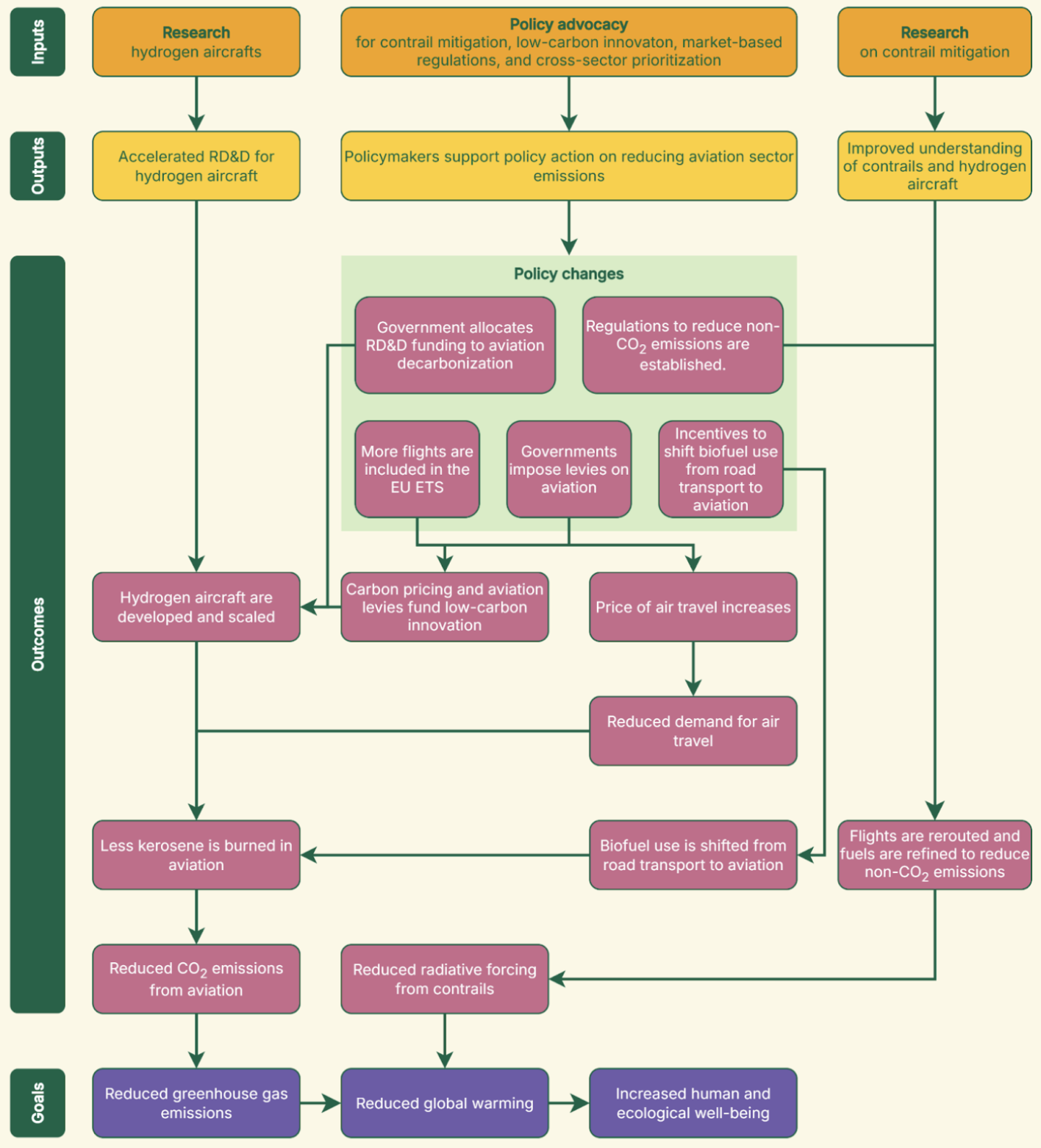
Evaluating Key Assumptions
1. Advocacy efforts push governments to adopt more ambitious policies to regulate aviation sector emissions. (medium certainty)
We think reaching net-zero sector emissions will require binding international commitments or a patchwork of robust national or regional measures. A growing number of countries have signaled intentions to adopt policies to encourage SAFs or impose levies on the aviation industry.103 We have high certainty that momentum for such policies will continue, but we have low certainty regarding the ambition levels based on our impression of (i) the lack of confidence in ICAO, (ii) the international nature of the sector, (iii) the complexity of decarbonization pathways, and (iv) lobbying efforts by the aviation sector against ambitious climate policy.104
We think the EU is an especially salient geography for policy advocacy. In the upcoming policy window for expanding the EU ETS, we have high certainty that the EU’s review will find that CORSIA is insufficient to meet the EU’s climate targets (see section: ICAO), and therefore, that the EU will be mandated to open discussions on expansion. However, we have low certainty that an expansion will include flights departing the EEA because the geographical expansion has already been delayed several times.105 We are also generally cautious about the current EU policy environment, which has shown less openness towards climate action since the 2024 election.106
We have medium certainty that the EU will continue its policy leadership to move forward with regulations targeting non-CO2 emissions, either as part of its ETS or through other policy mechanisms. It is increasingly recognizing the significant warming caused by contrails and has opened up research funding for contrail mitigation, but has not yet signaled that it will be a regulatory priority.107
As previously discussed, several aviation levies are also currently being discussed. We think government coalitions like the Global Solidarities Levies Task Force have raised the salience of such levies and could influence upcoming policy windows like COP30.108
2. Flight rerouting can reduce a large share of aviation emissions at low cost. (high certainty)
We have found consensus in the scientific literature that flight rerouting can significantly reduce contrail emissions while minimizing extra fuel burn. A 2022 meta-analysis conservatively estimated that 50% of contrail impacts can be reduced with only a 1% fleetwide fuel burn penalty, or a 0.2% increase in aircraft operating costs.109 Avoidance could be further increased if bottlenecks for air traffic congestion could be averted, or by developing better weather prediction models.110
Since 2022, progress in AI prediction models has further improved contrail avoidance capabilities. A six-month demonstration study between American Airlines, Breakthrough Energy, and Google found that pilots were able to reduce contrail emissions by 54% with a per-flight fuel burn penalty of 2%.111 Since persistent contrails are only formed in a small share of flights, this translates to a fleetwide fuel burn penalty as low as 0.3%.112
3. Hydrogen aircraft can be commercialized quickly enough to mitigate over 10% of aviation emissions in 2050. (low certainty)
Hydrogen-based aircraft have achieved multiple milestones in the last few years, including the successful test flights of hydrogen and hydrogen-electric planes by ZeroAvia and Airbus. Commercialization for hydrogen-electric cargo flights is also in progress. However, timelines for hydrogen aircraft have also seen setbacks in 2025. For example, Airbus delayed its goal of introducing hydrogen-powered commercial aircraft by 2035 by five to ten years, while Universal Hydrogen, one of the leaders in ZEA innovation, closed.113
Challenges to hydrogen aircraft rollout include the need for further advances in on-vehicle storage, especially to accommodate the weight of fuel cells and fuel tanks, and inadequate hydrogen production and distribution infrastructure.114 We are uncertain about the speed and scale of such innovations.
In a business-as-usual scenario, hydrogen aviation is expected to mitigate only 5-9% of aviation emissions in 2050.115 A high-innovation scenario could increase this share to 15-30% in 2050 and 30-70% in 2060.116 Overall, we think that the hydrogen aviation field will need substantial support from philanthropic and public funds to move towards a high-innovation scenario. We have low certainty that the field will draw sufficient funds to reach a high-innovation scenario.
4. Stricter regulations on aviation will lead to fewer CO2 emissions. (medium certainty)
Although we have low confidence in international regulations like CORSIA, we think some ambitious national regulations are being discussed that could lead to significant emissions reductions. The CO2 impact and revenue generation of various proposed regulations in the EU are summarized below:
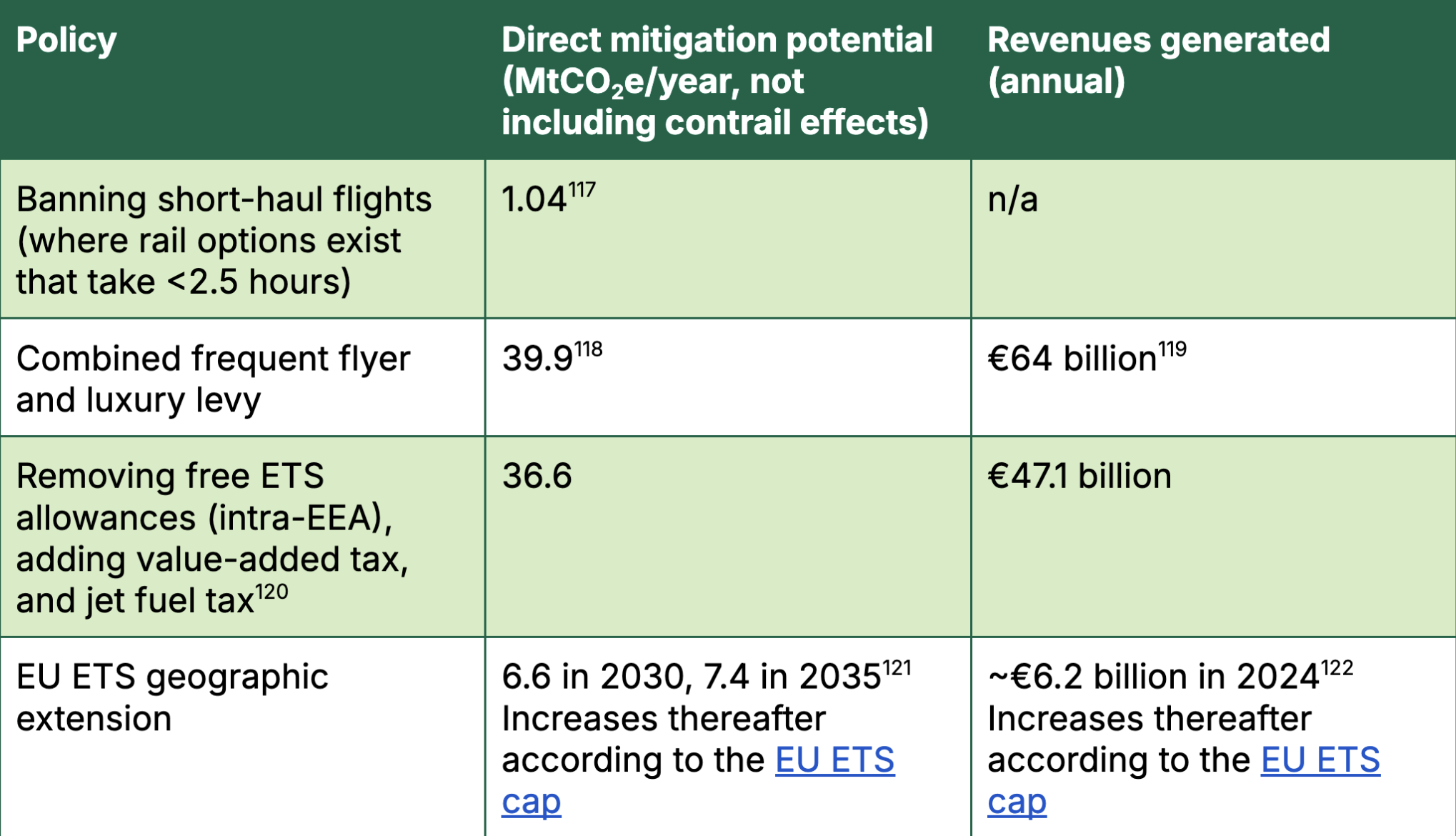
Further to the direct potential of aviation ETS and taxes, we think there could be huge indirect impacts if revenues generated from these regulations were used to fund technology innovation, one of our key drivers of systems change. We have high certainty that at least some revenues will be used to fund innovation in the EU. Out of the €33 billion in revenues generated by the EU ETS in 2023, most is spent by member states on ‘investments in renewable energy, energy efficiency improvements and low-carbon technologies.’123 Some revenues are also used explicitly to support technological innovation via the EU’s Innovation Fund, which is expected to raise ~€40 million from 2020 to 2030.124 Thus far, 20 million ETS allowances have been allocated to equalize the price gap between conventional and alternative fuels, and a further 5 million have been allocated to the Innovation Fund (the aviation ETS had a total of 29 million allowances in 2024).125
Local regulations must be designed to avoid carbon leakage, whereby stricter decarbonization regulations in one area, without protection mechanisms, cause emission sources to move to a different location and continue emitting greenhouse gases. This risk is especially relevant for aviation emissions because consumers can often choose to fly to other locations or use different air hubs. Regulations, such as the EU’s Carbon Border Adjustment Mechanism (CBAM), are intended to prevent such leakage and have shown promise in industrial sectors, influencing countries like China to accelerate the inclusion of certain heavy industry sectors in its own carbon market.126 Further empirical evidence will still be needed to confirm the CBAM’s effectiveness after it begins implementation in 2026, and countermeasures against carbon leakage from other sectors would need to be modified to be effective in the aviation sector, but early modeling shows that they have the potential to reduce emissions.127
5. Shifting biofuel use from road transport to aviation will lead to fewer system emissions. (medium certainty)
As previously discussed, we think the climate benefits of biofuels are often overstated, especially when LCAs fail to account for indirect land use change emissions, as in the U.S.’s 2025 revision to the Clean Fuel Production credit (45Z).128 Therefore, we think current levels of biofuel production could be harmful to mitigation efforts. Still, we think the biofuel industry will continue to exist, and there is value in allocating existing biofuels to end-uses where they are likely to have the largest potential to reduce emissions.
We have some hesitation in advocating for shifting biofuel use from road to air transport, since this diverges from the conventional narrative of climate groups, which tend to more strongly advocate for eliminating the use of crop-based biofuels. We are especially cautious that opening the door to greater biofuel usage could be co-opted by the biofuel industry to expand total production of biofuels, instead of transferring their use from road to air transport.
We think this sub-strategy will only work in geographies where a) policies incentivizing biofuel use in road transport are dismantled and b) strong standard-setting norms exist around biofuels that account for land-use change effects. We think that this line of advocacy is currently underrepresented in the SAF discourse and have medium confidence that thoughtful contributions from nonprofits acknowledging the scale-up challenges of both e-SAF and bio-SAF would be a valuable addition to policy discussions on the margin.
102 We describe our certainty as low/medium/high to increase readability and avoid false precision. Since these terms can be interpreted differently, we use rough heuristics to define them as percentage likelihoods the assumption is, on average, correct. Low = 0-60%, medium = 60-80%, high = 80-100%
103 “In the Asia Pacific region, in 2022 Japan proposed legislation mandating that SAF must account for 10% of aviation fuel by 2030. In the same period the Civil Aviation Administration of China also set ambitions to increase SAF use and lower GHG emissions intensity.” IEA , n.d. (accessed August 14, 2025); “Eight countries launch solidarity coalition for levies on premium flyers” Global Solidarity Levies Task Force, 2025
104 “The research further shows that many airlines have initiated extensive, climate-focused PR campaigns to deflect growing concern from governments and the public over the sector’s climate footprint.” Influence Map, 2021
105 “In light of the launch of CORSIA, this limitation has been extended several times. During the latest revision, it was extended one last time, until the start of 2027.” European Commission, n.d. (accessed July 31, 2025)
106 “EU policymakers have dealt several critical blows to their much-vaunted European Green Deal since the end of 2023, when opinion polls suggested a significant rightward shift before the 2024 parliamentary elections.” The Guardian, 2025
107 “As confirmed by a report from the European Aviation Safety Agency (EASA), the non-CO2 effects of aviation activities accounted for more than half (66%) of the sector’s net climate forcing in 2018.” European Commission, n.d. (accessed July 31, 2025) “It is complemented by financial support from the EU ETS Innovation Fund to mitigate the non-CO2 impacts, as well as the Horizon Europe research programme.” European Commission, 2024
108 “We are pleased to join the call by France, Kenya, Barbados, Spain and other countries to work towards COP30 on a better contribution of the aviation sector to fair transitions and resilience, with a special focus on premium flyers.” European Commission, 2025
109 “Contrail avoidance partly addresses the non-CO2 impact of aviation by reducing contrail impacts—perhaps conservatively estimated—by 50% for a 1% fuel burn penalty or 0.2% increase in aircraft direct operating cost.” Dray et al., 2022
110 “However, this mid-range value of 50% was selected since high rates of avoidance would cause increased strain on airspace and air traffic control, and maximum rates of contrail avoidance might be difficult to achieve with current weather prediction data.” Dray et al., 2022
111 “After these test flights, we analyzed satellite imagery and found that the pilots were able to reduce contrails by 54%.”; “The other significant finding of our test with American is the flights that attempted to avoid creating contrails burned 2% additional fuel.” Google, 2023
112 “Recent studies show that a small percentage of flights need to be adjusted to avoid the majority of contrail warming. Therefore, the total fuel impact could be as low as 0.3% across an airline’s flights.” Google, 2023
113 “The most high-profile setback came when Airbus pushed back its ambitious goal to introduce hydrogen-powered commercial aircraft in 2035. Citing a mix of infrastructure challenges and slower-than-expected technology development, it made the announcement during the Airbus Summit 2025 and expects a 5-10-year delay.” ICCT, 2025; “Universal hydrogen shut down after running out of cash…” Aerospace Testing International, 2024
114 “Hydrogen technologies such as fuel cells and combustion engines can offer greater range but face their own set of engineering hurdles, particularly concerning the need to develop lighter hydrogen storage tanks and more powerful fuel cells to minimize their significant mass and volume penalty. One of the major aircraft manufacturers, Embraer, recently pushed back its Energia project, a family of low-emission hybrid-electric aircraft, because both battery and hydrogen fuel cell advancements have been slower than hoped.”; “Infrastructure is probably an even bigger barrier. Airbus noted that inadequate hydrogen infrastructure—including hydrogen production, distribution, and fueling facilities, airport expansion and modification, and new safety protocols—is one of the major roadblocks to its ZEROe program.” ICCT, 2025
115 “Despite substantial progress in this field, hydrogen aviation is expected to contribute only 5% to 9% of emission reductions by 2050.” AIA, 2024
116 “In this scenario, hydrogen aircraft will reduce emissions by 15% to 30% in 2050 and 30% to 70% in 2060.” AIA, 2024
117 Table 2: Additional trains, CO2e savings and GTTS per marginal policy settings at the European level. Bruno et al., 2025
118 Table 2: Core impacts of an FFL implemented in 2028 against a baseline, no-FFL-policy scenario. New Economics Foundation, 2024
119 “A frequent flying levy across Europe would increase aviation tax revenues to €64bn, without any financial cost to the majority of people.” New Economics Foundation, 2024
120 “If national & European governments fail to remove tax exemptions, the tax gap is set to increase to €47.1 billion in 2025.” “On top of potential lost revenues, not changing policies to effectively price aviation would also lead to foregone emissions savings amounting to 36.6 Mt of CO2.” T&E, 2023
121 “The additional costs will affect the ticket prices of passengers (depending on the applied cost-pass through rate of airlines) and result in a reduction in demand and emissions by 6.6 Mt CO2 in 2030 and 7.4 Mt CO2 in 2035.” CE Delft, 2024
122 Calculation: 7.5*104.5/127.1 = €6.2 billion from Figure: Price of CO2 paid by top 10 most polluting airlines in 2024 (assuming revenues are proportional to emissions paid) “As such, extending the scope of the European carbon markets could unlock a further €7.5 billion that could fuel the green transition of Europe’s aviation industry.” T&E, 2025
123 “As carbon prices have increased significantly since 2017, so too have the revenues that EU Member States collect from the ETS auctions, from EUR 5 billion in 2017 to EUR 33 billion in 2023.” European Environment Agency, 2024
124 “it may amount to about €40 billion from 2020 to 2030…” European Commission, n.d. (accessed August 1, 2025)
125 “20 million ETS allowances (EUR 1.6 bn at an allowance price of EUR 80) have been reserved to cover some, or all, of the price gap between conventional fossil fuels and eligible alternative aviation fuelsuplifted from January 2024.” “5 million ETS allowances will be added to the Innovation Fund, which airlines and airports have always been eligible to access for support. The Innovation Fund can explicitly support the electrification of aviation, decarbonise the sector and mitigate its non-CO2 effects.” European Commission, n.d. (accessed 29 July 2025); “”The 2024 aviation cap amounts to 28 866 578 allowances. European Commission, 2023
126 “China will expand its national carbon trading market to include the steel, aluminum, and cement industries at the end of the year.” “Chinese authorities hope lower emissions will help soften the blow from a new carbon tariff, known as CBAM, to be imposed by the European Union from 2026.” Bloomberg News, 2024
127 “Instruments based on solutions for carbon leakage in other sectors, the Shipping EU ETS instrument and CBAM, are found to be not applicable in a direct way.” “All five assessed countermeasures to prevent carbon leakage have potential to work.” CE Delft, 2024
128 “The final bill also retained favorable changes to feedstock and emissions rules, including limiting the origins of feedstock to the US, Mexico, and Canada and clarifying that emissions attributed to indirect land-use change will not be counted.” Crux Climate, 2025
Cost-Effectiveness of Reducing Aviation Emissions
During American Airlines’ empirical study of contrail avoidance, contrails were avoided for an operational cost of $5-$25 per tCO2e, and other organizations claim even lower costs of less than $1 per tCO2e.129 This makes contrail avoidance a more cost-effective near-term measure to reduce warming than most other low-carbon technologies, as estimated by the IPCC. We expect philanthropic opportunities advocating for contrail avoidance to be more cost-effective than direct operationalization because advocacy groups can leverage much larger funding pools from governments and corporations.
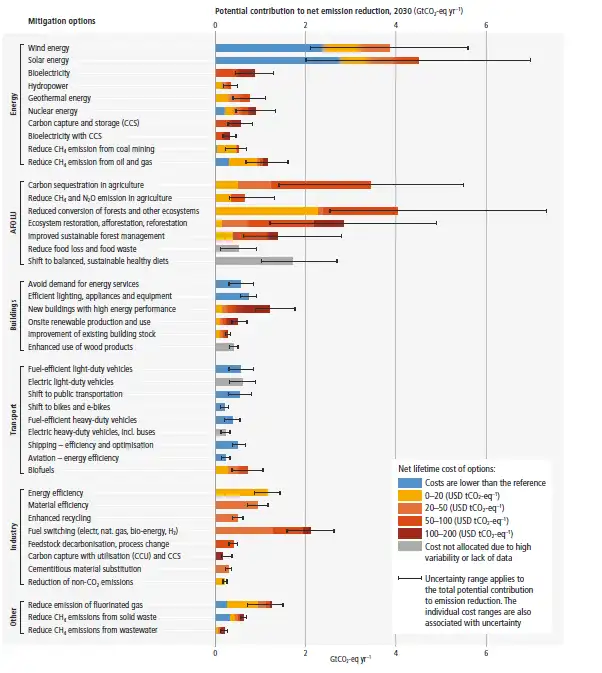
We also developed a cost-effectiveness analysis (CEA) to model the cost-effectiveness of policy advocacy efforts in the EU as a proxy indicator for the cost-effectiveness of reducing aviation emissions. In this analysis, we assume nonprofit advocacy efforts increase the likelihood that one or more of a) an ETS geographic expansion, b) a combined frequent flyer and luxury aviation levy, or c) a jet fuel tax, are passed. Our counterfactual is that these policies are instead passed after one additional EU policy cycle (five years). We modeled only direct effects from demand reduction, but think that the total mitigation potential could be even greater due to the indirect impacts, since some of the revenues from these levies would likely be used to fund climate innovation. Our best guess is that EU policy advocacy would avoid one tCO2e for around $1.84 (range: $0.14-$81.7). See the model for a high-level explanation as well as additional notes and citations.
This CEA is likely not generalizable to the overall cost-effectiveness of reducing aviation emissions, and it includes highly subjective guess parameters, so it should not be taken literally. Instead, it serves as a high-level sense-check of whether mitigation efforts in this area could be highly cost-effective. Overall, we think strategies to reduce aviation emissions could plausibly be in the range of cost-effectiveness we would consider for a top recommendation.131 Though we have low confidence in this CEA, we generally view it as a positive input to our overall assessment of reducing aviation emissions.
129 “This suggests that contrails could be avoided at scale for around $5-25/ton CO2e (carbon dioxide equivalent) using our existing predictions, making it a cost-effective warming-reduction measure, and further improvements are expected.” Google, 2023; “Better yet, properly implemented, these adjustments would be cheap: Our studies show a fleet-average cost of roughly $5.00 per flight, or less than $1 per tonne of CO₂ equivalent warming avoided.” Contrails.org, n.d. (accessed July 27, 2025)
130 Figure SPM.7: Overview of mitigation options and their estimated ranges of costs and potentials in 2030 IPCC, 2022
131 As a heuristic, we consider something to plausibly be within the range of cost-effectiveness we would consider for a top recommendation if its estimated cost-effectiveness is within an order of magnitude of $1/tCO2e (i.e., less than $10/tCO2e).
Is There Room for More Funding?
According to ClimateWorks’ data, transportation has only received $132 million (about 4%) of the $3.2 billion of annual foundation support for climate change (data averaged between 2019 and 2023).132 The vast majority of general transportation funding has gone to road transport. According to ClimateWorks’ 2023 annual report for its own grants, $49.2 million was directed toward road transport, and $4.7 million—or 8% of transportation funding—was directed toward aviation.133
Aggregated data of nine aviation climate funders estimated that <$10 million in philanthropic grants were active during 2024.134 We take this figure as the lower bound for aviation climate funding and estimate total philanthropic aviation spending to be between $10 and $15 million per year, or less than 1% of total philanthropic climate funding.
In terms of broader climate funding from the public and private sectors, Climate Policy Initiative’s Global Landscape of Climate Finance found that in 2022, aviation received $330 million (0.08% of the total of the $409 billion going towards transport).135 This total is far below estimates of aviation funding needed to reach net zero by 2050, which are $179-185 billion/year.136
Based on the low share of philanthropic and broader climate funding allocated to reducing aviation emissions and the large funding gaps present for the aviation sector to meet climate targets, we think that efforts to reduce aviation emissions have been underfunded compared to other climate interventions. Aviation has also been mentioned as a program area that nonprofits find especially challenging to fundraise for in several of our conversations, due to the small pool of active funders and the perception that the problem is ‘too difficult.’
Aviation funders include ClimateWorks Foundation ($4.7 million in 2023),137 Climate Imperative, the European Climate Foundation, Quadrature Climate Foundation, Children's Investment Fund Foundation, and Breakthrough Energy.
132 Figure 3: Known foundation support to regions, sectors, and strategies, 2019 to 2023, USD millions ClimateWorks, 2024
133 Page 5: Grantmaking & global programs, ClimateWorks, 2024
134 Funding survey of major philanthropic aviation funders, June 2025 (data is confidential)
135 Table A.6: Breakdown of Transport Sector climate finance by sub-sector (USD billion), data download, CPI, 2024
136 “Decarbonizing international aviation could require up to $5 trillion in technology investments through 2050” ICCT, 2023; “Industry requires over $5 trillion in cumulative investments to achieve net zero by 2050 (i.e. $179 billion annual investment, compared to current CapEx of $68 billion annually).” WEF, 2024
137 Page 5: Grantmaking & global programs, ClimateWorks, 2024
Are There Major Co-Benefits or Potential Risks?
Co-Benefits
- Improved air quality: Reducing jet fuel combustion decreases emissions of NOx, SO₂, and particulate matter, particularly around airports. One study found that replacing kerosene with alternatives could drastically reduce global excess mortality caused by particulate matter from aviation emissions.138
- Technological spillover: There is considerable technological overlap between low-carbon technologies in aviation and other sectors. For example, developing high-power-to-weight ratio batteries could enhance electric vehicle performance, and supporting the scale-up of electrolyzers and hydrogen distribution networks would advance the hydrogen economy, which would benefit green shipping, low-carbon industry, and low-carbon fertilizer production.
- Reduced adverse effects from noise pollution for communities near airports: Noise pollution around airports has been associated with increased risks of stroke, heart disease, and cardiovascular disease.139 Electric and fuel-cell planes are generally quieter than kerosene planes, which could reduce the burden of noise pollution around airports, but we are unsure of the share of aviation fleets they will comprise.140
Potential Risks
- High resource intensity: As previously discussed, many SAFs are highly resource-intensive. An overreliance on crop-based biofuels could result in harmful effects on food security and increased land-use change emissions. Overreliance on e-SAFs would require much greater renewable energy resources than are currently available, potentially lowering energy security.
- Cost burden and equity: Decarbonization measures that raise ticket prices would reduce access to flying, and flat taxes would disproportionately affect lower-income travelers. Luxury and frequent-flyer levies would be the most equitable approach to managing the demand for air travel, since the top 1% of fliers are responsible for more than half of aviation emissions.141 It is also worth noting that aviation is one of the few industries that is exempt from fuel taxes, an exemption that could be seen as already inequitable.142
138 “We found that while excess mortality due to the aviation sector emissions is greater in 2050 compared to 2006, improved fuel policies (technology and operations improvements yielding smaller increases in fuel burn compared to 2006, and conversion to fully sustainable fuels) in 2050 could lead to 72% fewer deaths for adults 25 years and older than a 2050 scenario with no fuel improvements.” Morita et al., 2014
139 “High levels of aircraft noise were associated with increased risks of stroke, coronary heart disease, and cardiovascular disease for both hospital admissions and mortality in areas near Heathrow airport in London.” Hansell et al., 2013
140 “At the same time, when flying at altitudes from 100 m, one should expect a decrease in the degree of audibility of unmanned aerial vehicle with electric power plants compared to piston ones.” Moshkov and Toropylina, 2024
141 “The percentile of the most frequent fliers – at most 1% of the world population - likely accounts for more than half of the total emissions from passenger air travel.” Gössling & Humpe, 2020
142 “Incredibly though, unlike British drivers, hauliers, rail operators and farmers, airlines do not pay tax on the fuel they burn.” T&E, 2024
Key Uncertainties and Open Questions
- Feasibility of scaling technologies to decarbonize aviation: Aviation is one of the most difficult sectors to decarbonize, as there is no clear, viable technological pathway. Given the limitations of sustainable biomass supply for bio-SAFs, the high cost of producing e-SAFs, and the technological breakthroughs needed to commercialize ZEAs, we think that a possible scenario is that the aviation sector cannot fully decarbonize, and our philanthropic dollars could be better spent on funding carbon removal to neutralize these emissions.143
- The tradeoff between scale and feasibility of regulations: We think that regulations leading to the most substantial emission reductions are likely to face considerable opposition from industry and other countries and have a lower likelihood of being enacted. We have already seen pressure from these groups repeatedly delay ETS expansion from its original proposal in 2011, and there has been considerable industry resistance to a frequent flier levy.144 We are uncertain whether sufficiently ambitious regulations will garner sufficient support to be enacted.
- The risk of international carbon leakage as a result of national regulations: Bespoke countermeasures would need to be designed to prevent carbon leakage. Although various mechanisms have potential, more research is needed to understand the effectiveness and legal feasibility of these proposals.145 More information about carbon leakage can be found in this report.
- The role of biofuels: As discussed above, we are unsure if advocacy encouraging the transition of biofuels from road to air transport will be taken in good faith by biofuel advocates, who may instead choose to use this narrative to maximize biofuel use across air and road transport.
- Transformative battery innovation: In many end-uses, including applications in road transport and heating, electric technology has become more viable than hydrogen-based alternatives. Although currently limited in range, we think it is feasible that battery innovations will significantly increase the mitigation potential of electric aircraft. Alternatively, we could see a paradigm shift in aviation, where intermediate stops are used to recharge electric aircraft.
143 “This is difficult in practice, and CDR could start well before 2050 to accommodate a more feasible trajectory of emissions reduction. It is followed by an increasing removal effort due to the rising RF induced by the fleet.” Sacchi et al., 2023
144 “When the EU was on the cusp of bringing international aviation into the ETS in 2011, it came under a prolonged spree of attacks levelled by the US government and aviation industry.” Carbon Market Watch, 2025; “IATA has rejected the proposal on several grounds, stating that the aviation industry is extremely competitive, has ‘thin’ net profit margins, and that the estimate of how much could be raised by such a tax is three times the airline industry’s global estimated profit.” Business Traveller, 2025
145 “All five assessed countermeasures to prevent carbon leakage have potential to work. However additional research (e.g. full work out of the instruments, legal analysis, effect analysis) is needed to definitely reject or approve countermeasures.” CE Delft, 2024
Bottom Line and Next Steps
In summary, aviation is projected to account for more than 20% of global CO2 emissions by 2050 if left unmitigated.146 Based on our research into sub-strategies that could decrease aviation emissions, we believe research and advocacy for reducing the non-CO2 impacts of aviation, advocacy for market-based aviation regulations such as progressive levies and ETS expansion, and the development of hydrogen aircraft could substantially reduce emissions. Due to the low level of funding this impact area has received and its projected share of future emissions, we plan to consider organizations working on these topics for our Top Nonprofits and as potential grantees from the Giving Green Fund.
146 “If, as in the past, the ambition of these sectors continues to fall behind efforts in other sectors and if action to combat climate change is further postponed, their CO2 emission shares in global CO2 emissions may rise substantially to 22 % for international aviation” EU, 2015
Acknowledgments
This work has greatly benefited from the feedback provided by a variety of advisors, experts, and reviewers throughout the research process; Giving Green is grateful for those who shared their time, experience, and ideas. We would especially like to acknowledge the principal reviewer, Anna Stratton, for providing a deep review of this strategy report during its final stages of development.147 All opinions remain those of Giving Green alone, and any remaining errors are our own.
147 Anna Stratton is the Associate Director of Aviation at Climateworks Foundation.
Support Our Work
Giving Green Fund
One fund. Global impact. One hundred percent of your gift supports a portfolio of high-impact climate organizations, vetted by our research.
Best for:
Donors who want the simplest way to impact multiple climate solutions.
Top Climate Nonprofits
Meet the organizations on Giving Green’s list of high-impact nonprofits working to decarbonize our future, identified through our rigorous research.
Best for:
Donors who want to give directly and independently.
Support Our Work
We thoroughly research climate initiatives so you can give with confidence. For every $1 we receive, our work unlocks another $21 for effective climate solutions.
Best for:
Donors who want to amplify their impact through research.





.png)
.jpg)
.png)
.png)



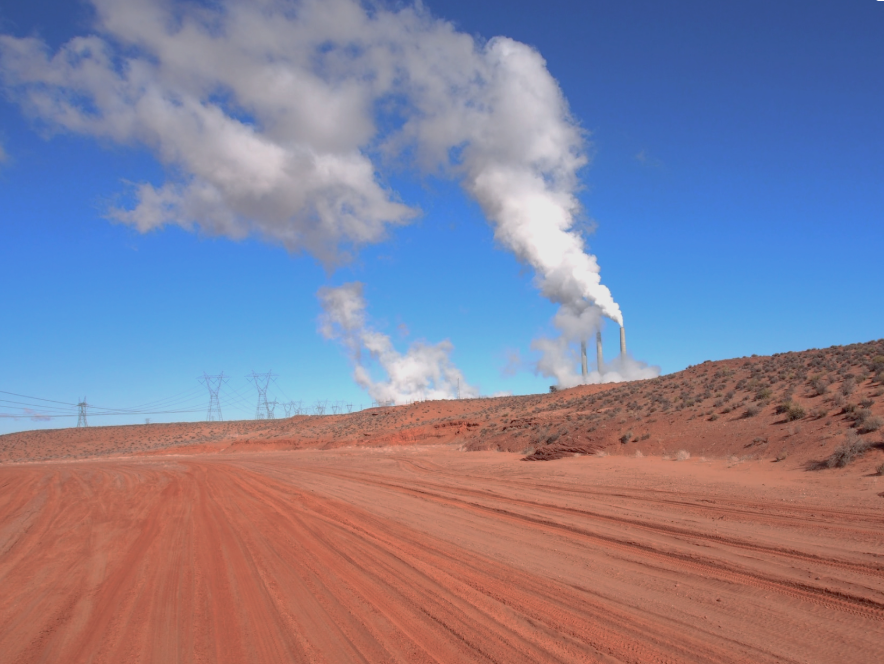
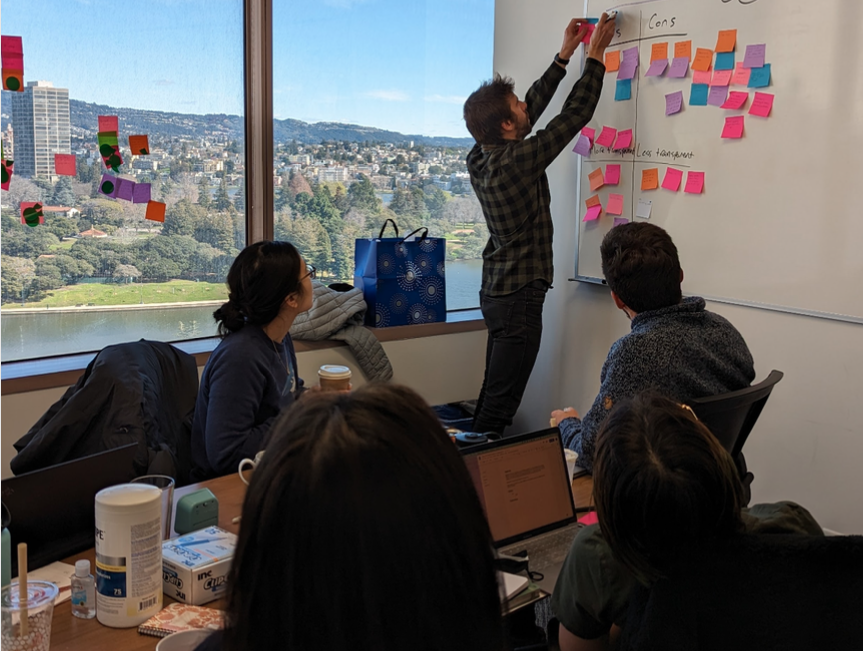
.png)
.png)

.png)



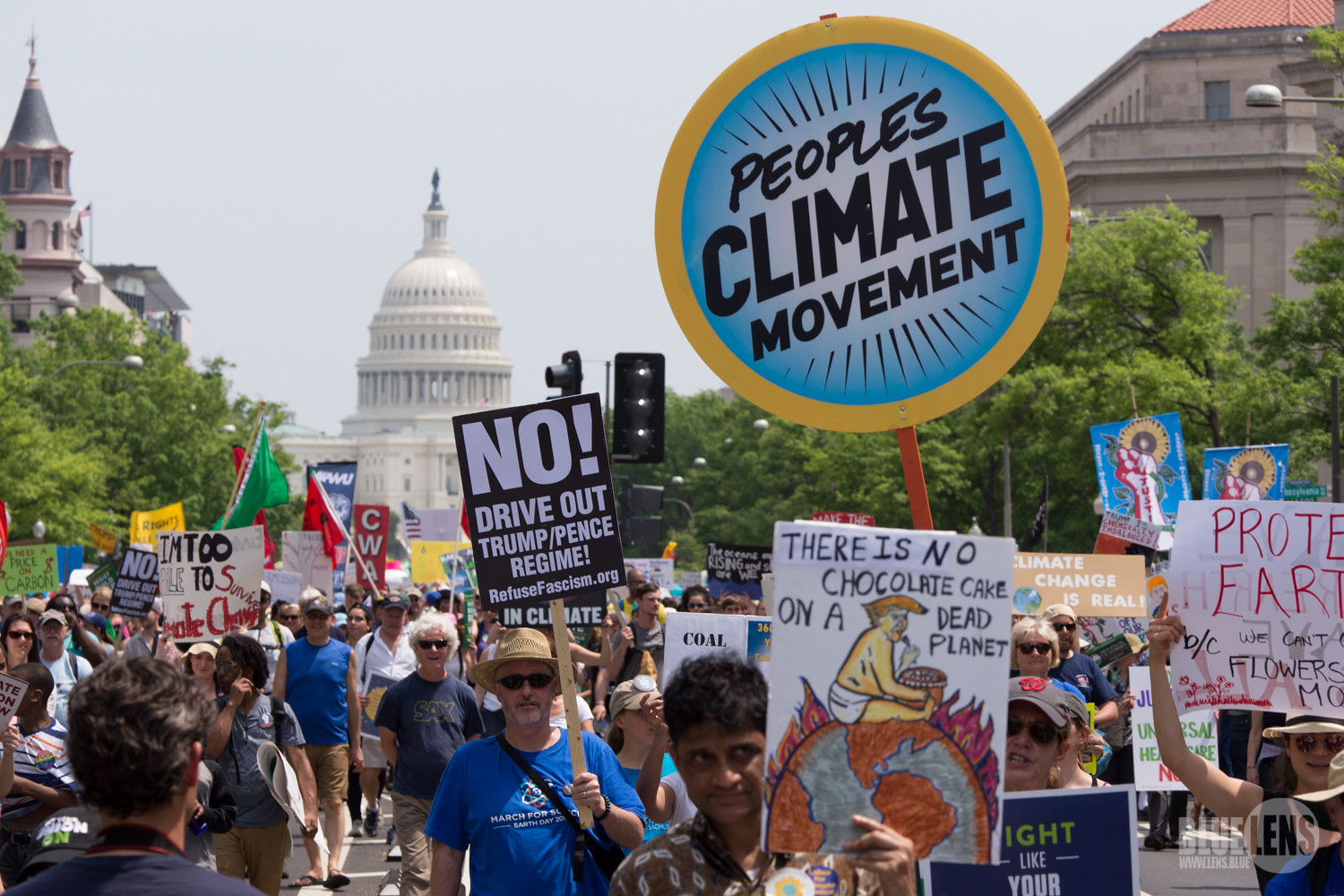


.png)

.png)
.png)
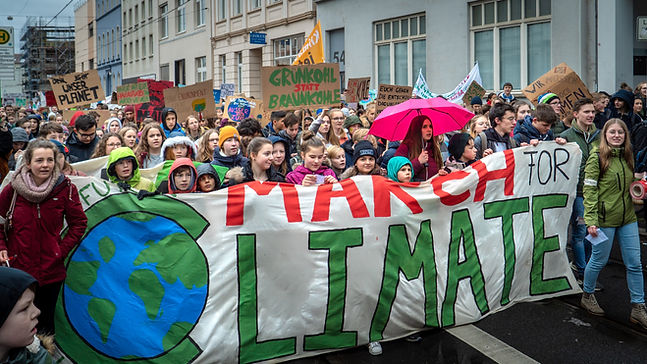
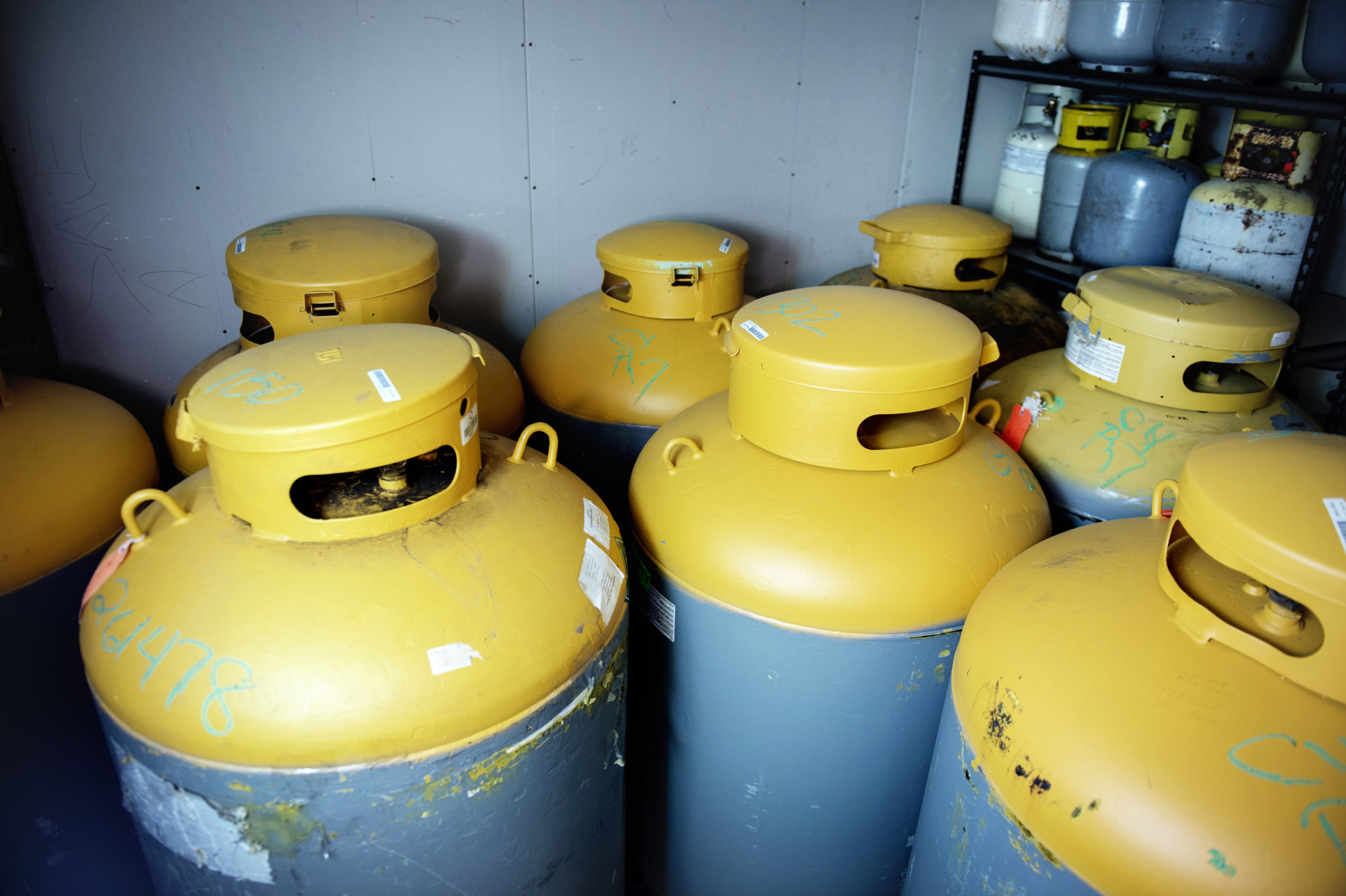
.png)
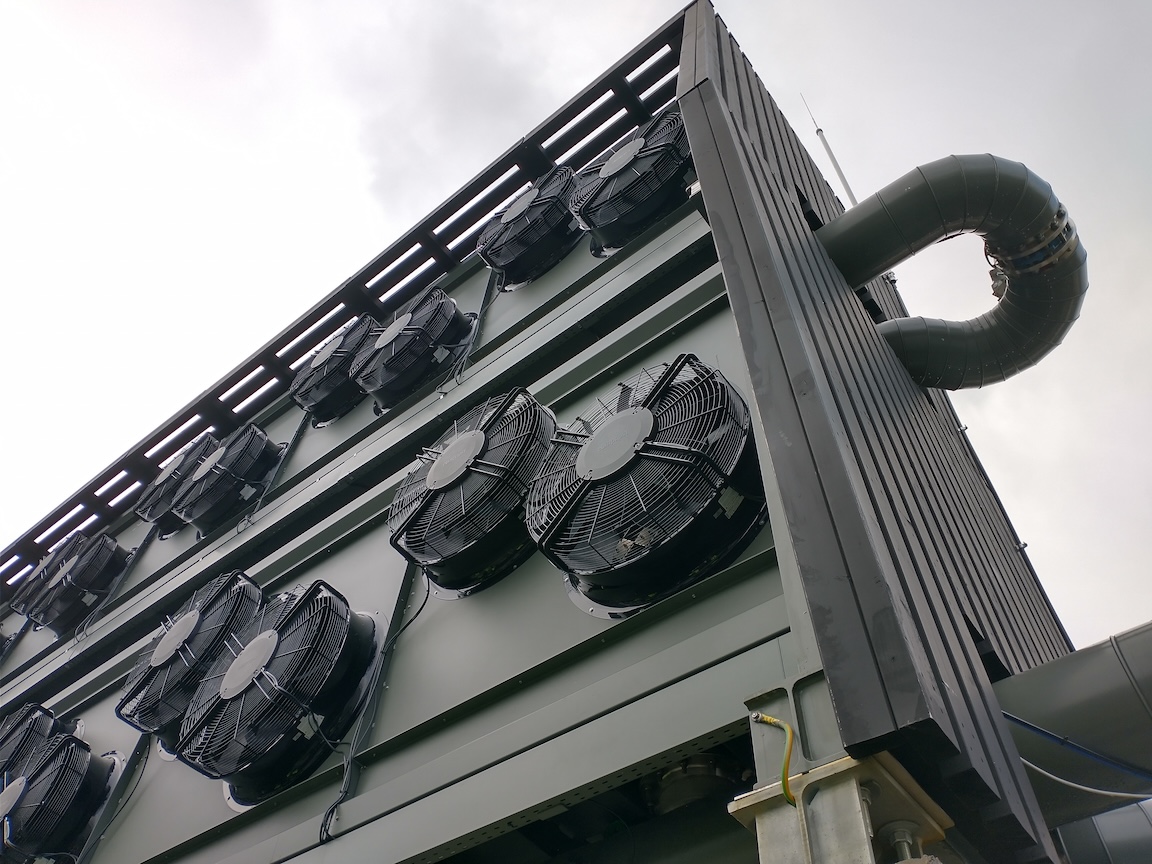
.png)
.png)






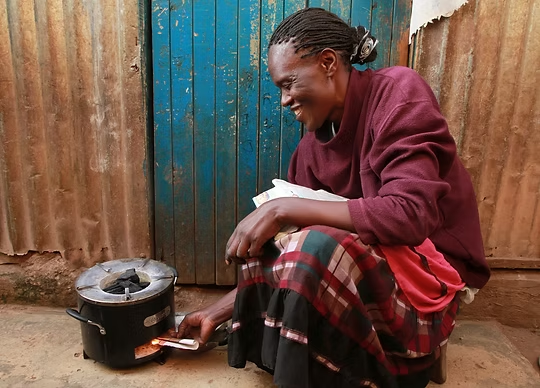
.png)
.png)
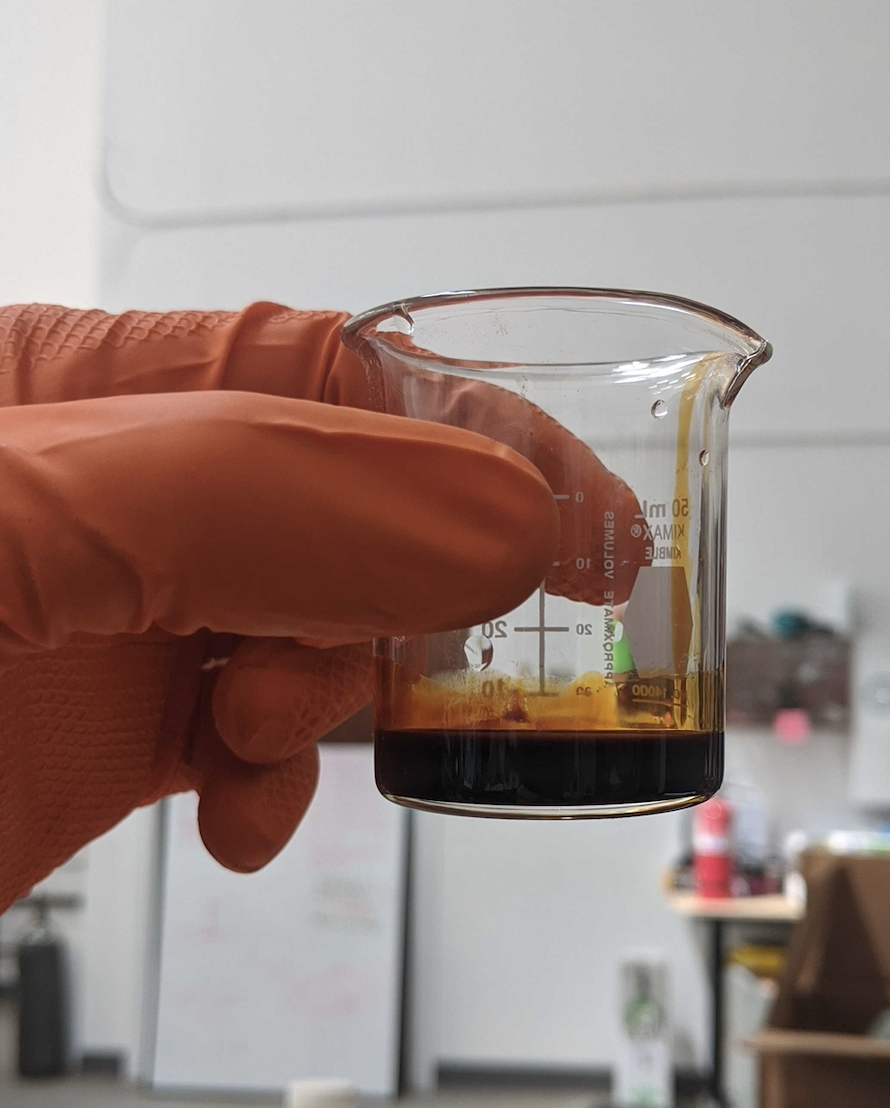



.png)
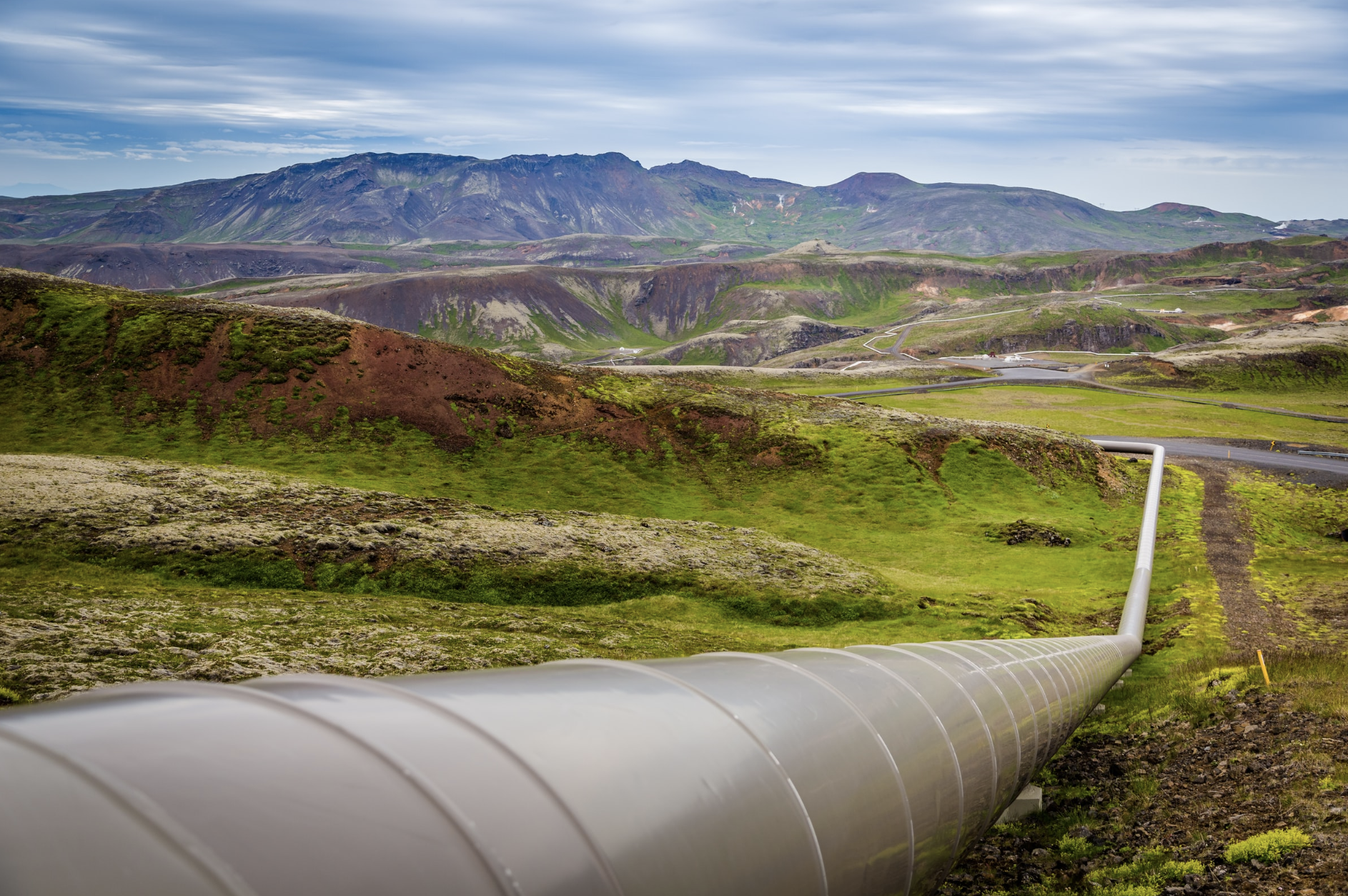
.png)
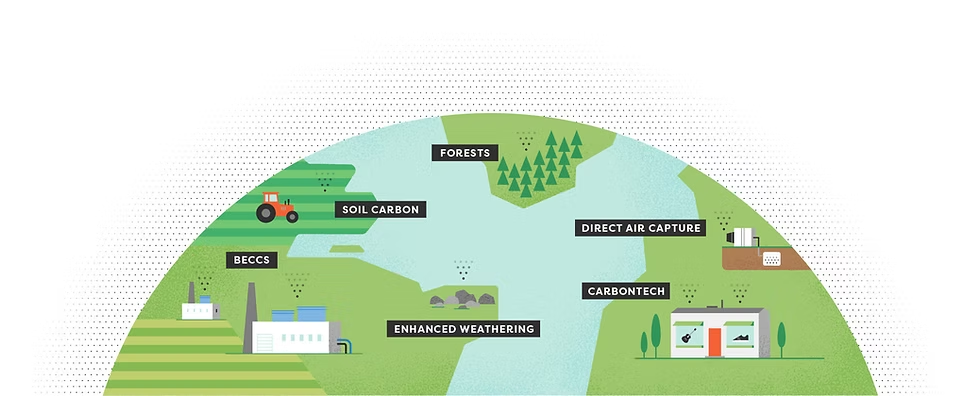
.png)
.png)


.png)

.png)



.png)
.png)
.png)

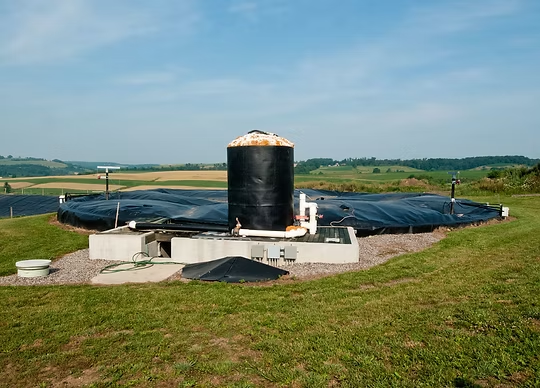
.png)
.png)


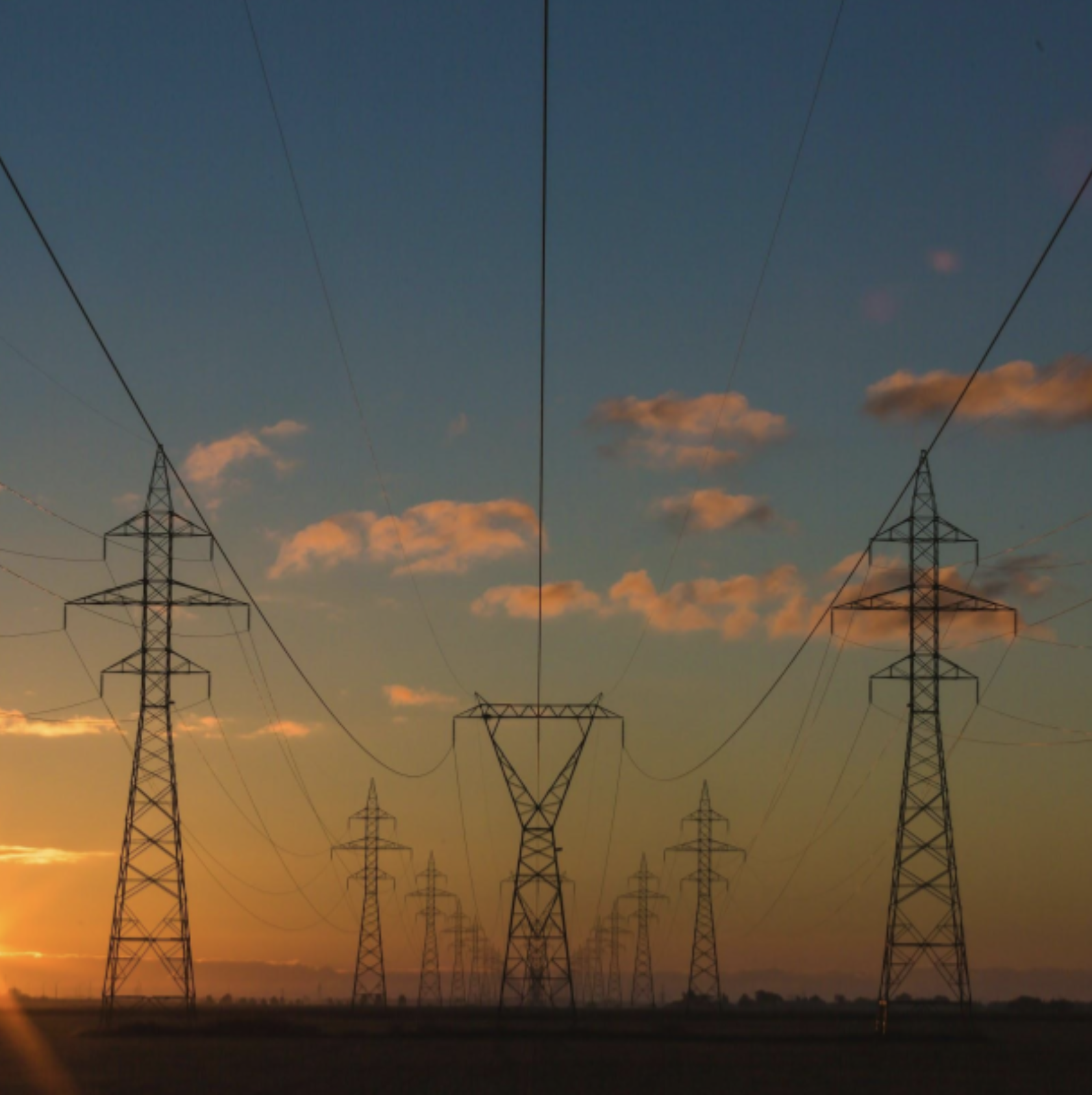


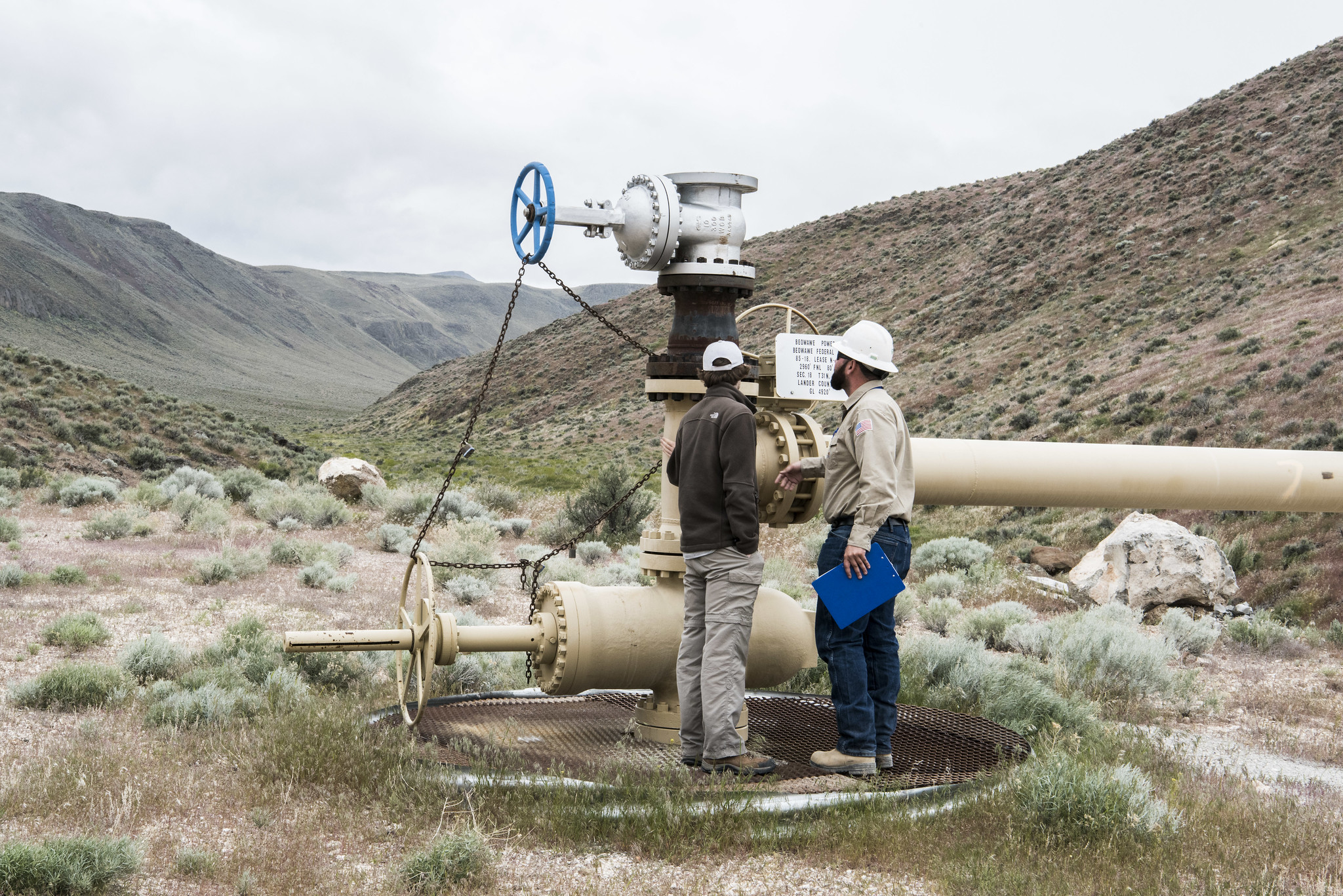




.png)

.png)

.png)
.png)

.png)

.png)
.png)
.png)
.png)
.jpg)
